- AROUND THE SAILING WORLD
- BOAT OF THE YEAR
- Email Newsletters
- America’s Cup
- St. Petersburg
- Caribbean Championship
- Boating Safety
- Ultimate Boat Giveaway


Class 40 Mighty Mites
- By James Boyd
- May 23, 2023
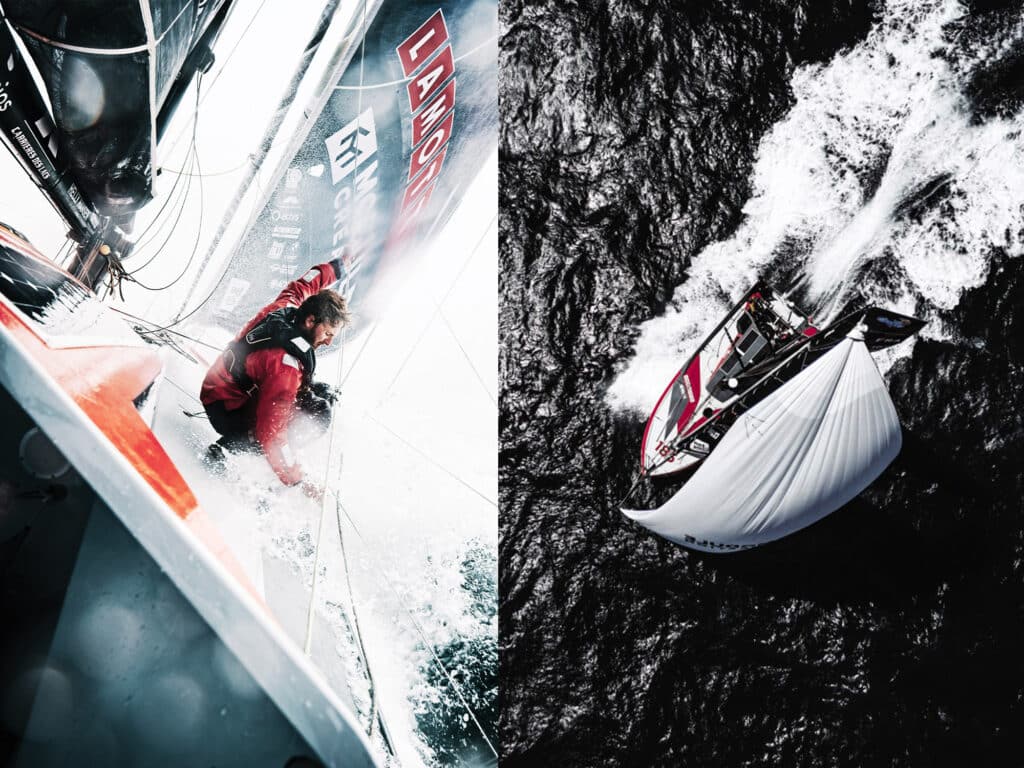
For sailing fans visiting from outside France, the Route du Rhum is a cultural shock, barely to be believed even once seen. It is France’s oldest singlehanded race, first held in 1978, and run every four years from St. Malo in northern France 3,500 miles across the North Atlantic to Guadeloupe. The fleet of 138 boats that assembled for the start in November 2022 was incredible, with an estimated value of 260 million euros—from the implausible 100-foot Ultime trimarans to a record fleet of 38 IMOCA 60s and a similarly impressive fleet of 55 Class40s. Dock sides are crammed with spectators, many hoping to catch a glimpse of the top skippers—some are genuine sports stars. Had the 2022 start not been delayed, French President Emmanuel Macron was to have attended. It’s that much of a big deal.
In the days and hours before the Route du Rhum started, more than 1 million people passed through its race village in St. Malo. In this environment, even non-French amateurs, such as the two US Class40 skippers, Alex Mehran and Greg Leonard, gained celebrity status with relentless autograph signing, selfies with fans and press interviews. Usually outshone by the bigger, higher-profile boats, the Class40 is the most successful 40-footer of all time. While the Farr 40 never topped more than 40 boats at a world championship, this is the second Route du Rhum in which more than 50 participated. To date, 192 Class40 hull numbers have been allocated.
While “Open 40s” once competed in the OSTAR and Around Alone, the Class40 came about independently. Born in France in the early 2000s, two designs defined the class: the Pogo 40 and the Jumbo 40. But the success and longevity of the Class40 is due to its highly constrictive box rule, drafted by a group that includes wise French sailor and journalist Patrice Carpentier, which remains robust 18 years on.
The box rule’s basic parameters are a maximum length overall of 39 feet, 11 inches; max beam of 14 feet, 9 inches; draft of 9 feet, 10 inches; average freeboard of 3 feet, 6 inches; max mast height of 62 feet, 4 inches; max working sail area of 1,238 square feet; minimum displacement at 10,097 pounds; and max water ballast of 1,653 pounds per side. Most brutal are the materials limitations: Carbon fiber, aramid, honeycomb cores and pre-preg resin are forbidden from the construction of the hull, deck, interior structure and fittings; go down below on one and, joyously, thanks to the GRP construction, it is not coffin black.
Carbon fiber is permitted for the mast, boom and bowsprit, while standing rigging must be steel rod. Sails are limited to eight, and all but two and the heavy-weather jib must be polyester and nylon. A single fixed keel and as many as two rudders are permitted, but daggerboards and foils are banned, as are canting, rotating masts, mast jacks, and adjustable or removable forestays. However, complex kick-up rudders are permitted. (Although their effectiveness to kick up in a collision is allegedly dubious.) Over the years, displacement and average freeboard have slightly reduced, but the biggest rule amendment has limited “how scow” Class40 hull shapes can be. While the latest foiling Protos in the Classe Mini (the “flying bathtubs”) are fully flat-bowed, Class40 has two max beam limits just short of the bow to prevent this. Naturally, costs have risen, but the rule has successfully limited them; today, a top Class40 costs 700,000 to 800,000 euros.
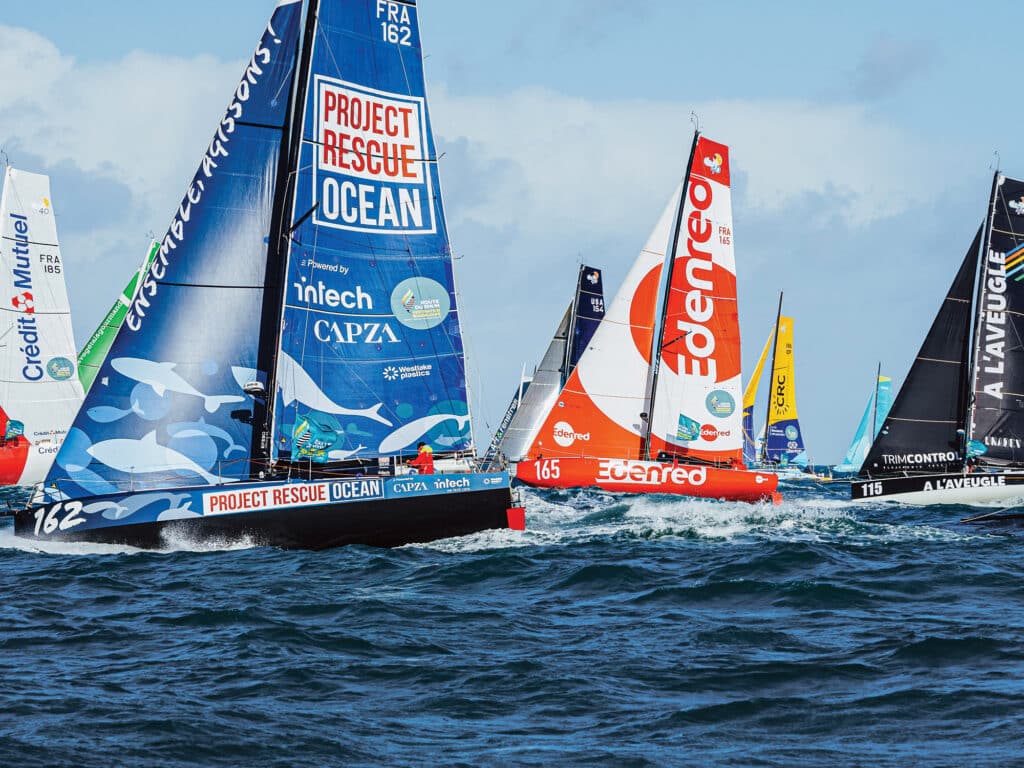
Those sailing the Class40s in the early days were a mix of pros and amateurs. Today professionals on sponsored boats are the majority. As for aspirant French pro sailors, the Class40 has become a significant stepping stone between from the Classe Mini and Figaro circuits to the IMOCA.
As skipper of Groupe SNEF , leading Mini and Figaro skipper Xavier Macaire says: “The transatlantic races like this [Route du Rhum] are very interesting to us, and the boat is not very expensive. The Class40 is easy to maintain and prepare, and is not a complicated boat like an IMOCA where you need 12 guys. With this, you need two or three, not full time. It is an easy, fast boat.”
With more top pros like Macaire joining, 30 new Class40s have been launched in the last four-year cycle. The most recent Route du Rhum podium, for example, comprised two-time Solitaire du Figaro winner Yoann Richomme ( Paprec Arkea ) and Mini Transat winners Corentin Douguet ( Queguiner-Innoveo ) and Ambrogio Beccaria ( Allagrande Pirelli ) of Italy.
Of the French classes, the Class40 and the Mini remain the most cosmopolitan, with entries from other European countries, notably Italy at present, while the United States, Australia and South Africa were also represented in the Route du Rhum. Far from being put off by the pro element, Americans Alex Mehran and Greg Leonard were thrilled to be on the same starting line. “It is such a privilege to race against some of the top offshore sailors in the world,” says Leonard, who hails from Florida. “It is like playing football against a first team in the NFL—it is that level of quality. There are not that many sports you can do that in.”
Both American skippers came to the Route du Rhum from similar paths. With his Mach 40.3 Kite , Leonard is a professional economist originally from Texas. He campaigned a J/120 for many years with his remarkable son Hannes, who raced his first doublehanded overnighter with his father at age 13. Now 18 and with thousands of race miles under his belt, both in the US and Europe, he is a Class40 expert. For his father, the Route du Rhum was his first singlehanded race.
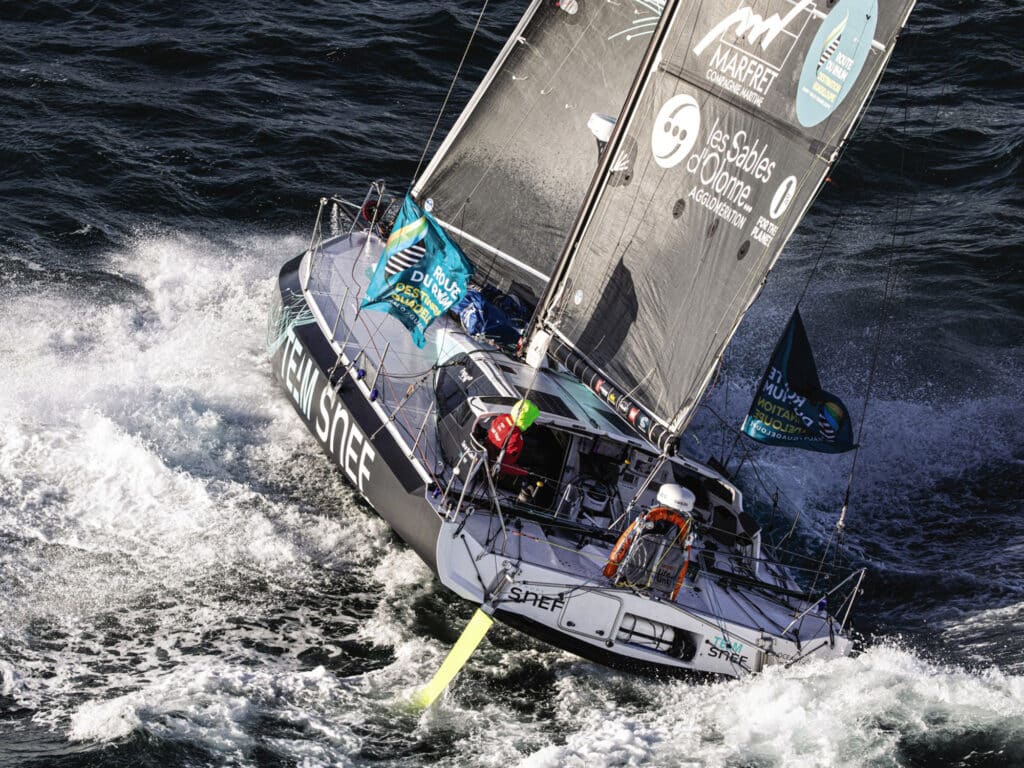
Over the years, several top shorthanded sailors, notably British Vendée Globe skippers Mike Golding and Miranda Merron, have raced with him, also coaching him. He is very enthusiastic about the Class40: “They are beautiful boats, such fun to sail. When we delivered her to St. Malo, we had 28 to 40 knots just aft of the beam, and we just hung in the low 20s boatspeed, and it was finger-light steering.”
Mehran skippers Polka Dot , which has the perfect pedigree, being Yoann Richomme’s 2018 Route du Rhum winner—a Lift V1 design. Growing up as part of the St. Francis YC Laser squad and subsequently a Brown collegiate sailor, he met Welsh Class40 designer Merfyn Owen in 2009 and raced one of his designs. Remarkably, he won his first major singlehanded race, the 2009 Bermuda 1-2. He subsequently graduated to an Owen Clarke-designed Open 50, in which he set a record in 2012’s singlehanded Transpac. He then went off, had four kids, and developed his commercial real estate business before getting the itch once more last year. He competed doublehanded with Owen in the 2021 Transat Jacques Vabre on an old Class40, but as Mehran puts it, “We needed to get something scow.”
He too has been receiving coaching from Merron and Golding, among others. According to Mehran, one of the most difficult things to explain to those back home is less the offshore-racing fever that afflicts French fans, but that their skippers are not multimillionaires. Instead, they come from a wide age group and all have commercial backing to either buy a secondhand boat or—if they are higher-profile, more accomplished or just plain lucky—build a new one. So, returning to the Route du Rhum podium, Paprec’s business is waste disposal (admittedly, its owner races his own Wally 107), Arkea is banking and insurance, Queguiner is building materials, Innoveo is an app-development platform, and Pirelli makes tires (its CEO has a Wally 145).
Over the last two decades, the Class40s themselves have evolved, despite Draconian design limitations. What started as cruiser-racers with fitted-out interiors became racer-cruisers and are now refined pure racers. They may not be black inside, but the build quality of the latest-generation designs is of the highest standard, and it seems no longer possible to buy a cruiser-racer.
A delight of the Class40 is that no one designer is dominant; eight different designs make up the 30 boats built over the last four years. Pogo Structures, last of the original builders, is on its fourth version of its Pogo 40, the S4, designed by Emirates Team New Zealand’s naval architect, Guillaume Verdier (who also designed Structures’ scow-bowed flying Proto Mini).
The man who developed the first blunt-fronted scow Mini, David Raison, produced the Max40, built by JPS in La Trinité-sur-Mer. Also built by JPS are Sam Manuard designs—the Mach 40.4, such as the 2021 Transat Jacques Vabre winner Redman , skippered by Antoine Carpentier (nephew of the original rule’s writer), and now its evolution, the Mach 40.5, of which two competed in the Route du Rhum.
In 2020, VPLP made its first foray into the class with the Clak 40, built by Multiplast, of which four raced in the Route du Rhum, the top finisher being Martin le Pape’s Fondation Stargardt. Etienne Bertrand, another successful Mini designer, had two Cape Racing Scow 40s in the race, while Allagrande Pirelli , believed to be the most expensive of the latest crop and campaigned by last year’s Mini Transat winner, Ambrogio Beccaria, is an all-Italian affair designed by Gianluca Guelfi and built by Sangiorgio Marine Shipyard in Genoa.
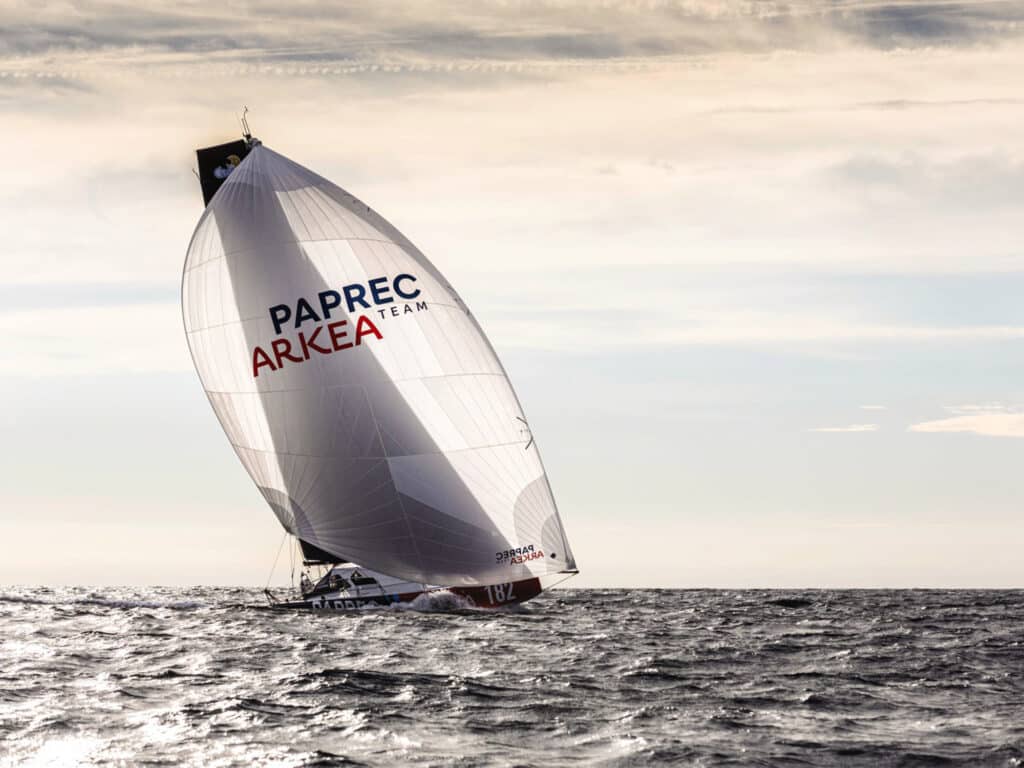
However, after the recent Route du Rhum, nosing in front in the design race is Marc Lombard with his Lift V2s, of which seven were racing, including Yoann Richomme’s winner, Paprec Arkea . Lombard is one of the longest continuous players in the Class40, and has worked with Tunisian manufacturer Akilaria on its RC1, RC2 and RC3 models since 2006, of which 38 were built. His latest designs have been the Lift, introduced in 2016; Veedol-AIC , one example, took Richomme to his first Route du Rhum victory. The Lifts were custom-built with a hull and deck made by Gepeto in Lorient, but finished off by the V1D2 yard in Caen, and were more precisely engineered and built than the Akilarias. They were superseded this cycle by the Lift V2, the most popular of the new Class40s, with seven competing.
For Richomme, the Route du Rhum was a small distraction from having a new IMOCA built. He entered the Route du Rhum to defend his title and stay race-fit. If the first Lift was an early scow, the present one is at the limit, to the extent that it has a bump in the hull 2 meters aft from the bow at the limit of where the Class40 rule restricts the max beam to prevent such extreme scowness.
The scow bow provides more righting moment, but it also does interesting things to the boat’s hydrodynamics. “With a pointy bow, the keel is more angled and creates more drag,” explains Richomme, who is also a trained naval architect. “When a scow heels, the hull is almost parallel to the keel, so sometimes when we go over the waves, we can feel the keel shudder when it is producing lift. The chine is low and therefore very powerful, and when we heel, it makes for a very long waterline length. Also, we have very little rocker, whereas other [new] boats have a lot, which creates a lot of drag so they don’t accelerate so well when they heel.”
The Lift V2 “is a weapon reaching,” Richomme says. “We can hold the gennaker higher than we used to. Last time, I didn’t even take one. But with the power going up, so have the loads, and we are having problems with the hardware. I have broken two winches already.”
A downside of the big bow and straight chine is downwind, where the technique seems to be preventing the bow from immersing. Paprec Arkea is typically trimmed far aft, including the stack and the positioning of the 1,653 pounds of water ballast (most new boats have three tanks each side), while its engine is 19 inches farther aft, and the mast and keel 11 inches farther aft than they were on his previous boat. They are 77 pounds below the minimum weight, which Richomme admits may be too extreme—during training they broke a bulkhead.
Otherwise, their increased cockpit protection is most noticeable on all the new designs (although not to IMOCA degrees), while most have a central pit area with halyards fed aft from the mast down a tunnel running through the cabin. On Paprec Arkea , a pit winch is mounted just off the cockpit sole. With the main sheet and traveler lead there as well, Richomme can trim from inside the cabin.
Most extraordinary about the scows is how fast they are. Anglo-Frenchman Luke Berry, skipper of Lamotte-Module Création , graduated from a Manuard Mach 40.3 to a 40.5 this year and says: “It is a massive improvement both in speed and comfort. Reaching and downwind, we are 2 knots faster, which is extraordinary.”
The top speeds he has seen are 27 to 28 knots. “Most incredible are the average speeds—higher than 20.”
This effectively turns yacht-design theory on its head, with waterline length and hull speed having less effect upon defining the speed of a boat that spends so much time planing. On the Mach 40.5, the waterline is just 32 feet, with a length overall of 39 feet. Compared to the Lift V2, it has more rocker, supposedly making it better able to deal with waves.
Nowhere is the speed of the latest Class40s more apparent than where they finished in the Route du Rhum in comparison to the IMOCA fleet. Paprec Arkea arrived in Guadeloupe ahead of 13 IMOCAs, or one-third of the way up the IMOCA fleet. Richomme says he used to sail on a Lombard-designed IMOCA 20 years ago, when they would make 10.5 knots upwind. “On a reach, I reckon we are faster than them now. We can do 20 to 22 knots average speed.”
Ugly seems to be quick, but when it comes to the Class40, beauty is in the eye of the beholder of the trophy.
- More: Class 40 , Offshore Racing , Print March 2023 , Racing , Sailboat Racing
- More Racing

Cole Brauer’s Voyage of Influence

New Extremes On the Horizon

The Skimming Superyacht

Improve Your Weeknight Race Results

Townie Showdown in the Harbor
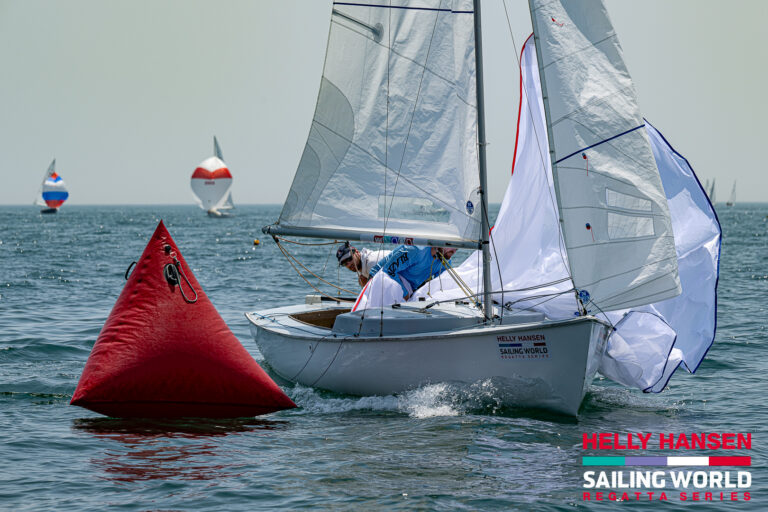
Haves and Have Nots On Marblehead Regatta’s Second Day

Regatta Series In Marblehead Starts With a Twist

- Digital Edition
- Customer Service
- Privacy Policy
- Terms of Use
- Cruising World
- Sailing World
- Salt Water Sportsman
- Sport Fishing
- Wakeboarding
Sailboat collection

- Last update: 1st April 2020
- OC Wally Cento
- 84 Mini Maxi
- IMOCA Open 60
- Consultancy Services
- 30m Blue Water Cruiser
- 25m Explorer Yacht
- 24m Fast Cruising Catamaran
- 23m Performance Cruiser
- 20m Explorer Yacht
- 20m High Performance Cruiser
- 18m Blue Water Cruiser
- 15m Performance Cruiser
- 15m Explorer Yacht
- 12m Explorer Yacht
- Multihull Design
- 18m Explorer Yacht
- 40m Blue Water Cruiser
- 40m Cruiser Racer
- 33m Performance Cruiser
- 30m Wally Cento
- 24m ORCsy Racer Cruiser
- 24m Day Sailer
- Carbon Component Design
- Yacht Performance Development
- CFD and Model Testing
- Twin Rudder Steering Systems
- Custom Deck Hardware
- Modifications and Refit
- VPP Routing and Sail Analysis
- Classic Yacht Refit & Optimisation
- Naval Architecture
- Engineering
- Rudder Design
- Brokerage Services
- 'Seahorse Magazine' #192
- 'Divoc' #190
- Lucent #180
- Influence #171
- 'Eora' #169
- 'The Three Brothers' #168
- 'Edenred' #165
- 'BHB3' #163
- 'Teata' #148
- 'Kite' #144
- ‘Sensei’ #131
- 'Gryphon' #106
- 'Sabre II' #93
- 'Letto Di Pletto' #47
- 'Mowgli' #41
- 'Graybeard' #39
- 23.8m Ultime Trimaran
- 20.7m Orma Trimaran
- 18.28m Orma Trimaran
- 16.75m Cruising Catamaran
- 16.1m Cruising Catamaran
- 12.8m Crowther Shockwave Catamaran
- 9.1m Seacart 30 Trimaran
- 26.3m Aluminium Sloop
- 22.38m Aluminium Classic Yacht
- 21.0m Steel Schooner
- 21.0m Aluminium Cruising Ketch
- 20.0m Aluminium Explorer Yacht
- 20.0m Luca Brenta Racer Cruiser
- 19.6m Aluminium Bluewater Cruiser
- 19.2m Aluminium Lifting Keel Sloop
- 18.8m Custom Steel Sloop
- 18.23m Mylius Racer Cruiser
- 16.0m Sly Cruiser Racer
- 14.5m Aluminium Cruising yacht
- 13.87m Wooden Motor Sailer
- 11.6m Classic Pilot Cutter
- 25.25m Reichel Pugh Maxi
- 18.28m IMOCA 60 Nexans WeWise
- 18.28m IMOCA 60 'Canada Ocean Racing'
- 18.28m IMOCA 60 One Planet
- 15.85m TP52 Georgia
- 15.84m TP52 Racing Yacht 'Alizee'
- 15.25m Pegasus Open 50
- 12.8m Fast 40
- 10.89m Figaro 3
- 19.2m Lifting Keel Sloop
- 14.5m Aluminium Cruising Yacht
| Owen Clarke Design have been involved with the development of Class 40's since the rule’s inception back in 2005 and have now produced fourteen custom/semi–custom and five production boats, since 2006. Our designs have been Class Champion, won or placed on the podium in events such as: Class 40 Mondial/ISAF Worlds, Route du Rhum, Round Britain and Ireland Race, Normandy Channel Race, Atlantic Cup, Bermuda Race, Bermuda 1-2, Marblehead-Halifax and the Transat Jacques Vabres. In the 2019 season our previous generation design and the first to be raced by a professional duo, #157, Imagine, finished third in the 2019 Normandy Channel Race, second in the La 40 Malouine in St Malo and a close run sixth in a very demanding and record breaking Transat Jacques Vabres (TJV). More recently Merf Owen, the lead designer of Dragon 2, our newly built Class 40 scow raced and completed his second TJV on the Marc Lombard designed 40, PolkaDot. Click image for video . As well as active design and build support (five visits to the yards for the the current boat), OC continue to update and conduct tender processes with yards, sail-makers and suppliers worldwide and have a considerable amount of information and costings that allow our boats to be built anywhere in the world. For those sailors and owners who have not commissioned their own boat before we have produced a useful guide describing the design and build process. It answers many of the questions you're likely to have about commissioning the build of a custom or semi-custom race boat.For an explanation of the technology behind the design process go to: For an insight into our engineering and detailed design work go to: For the largest global selection of pre-owned class 40s visit: |


A Class 40 Racing Yacht. From Cardboard.
- August 24th, 2016
- Sailing Yacht
Dedicated readers of this NO FRILLS SAILING.com sailing magazine know that I do have a certain obsession with Class 40 racing yachts. They are damn fast, look pretty awesome and need special abilities when boarded to be sailed. Since that very moment I first set foot in a Pogo 40 racing yacht some weeks ago I was fascinated with these ships.
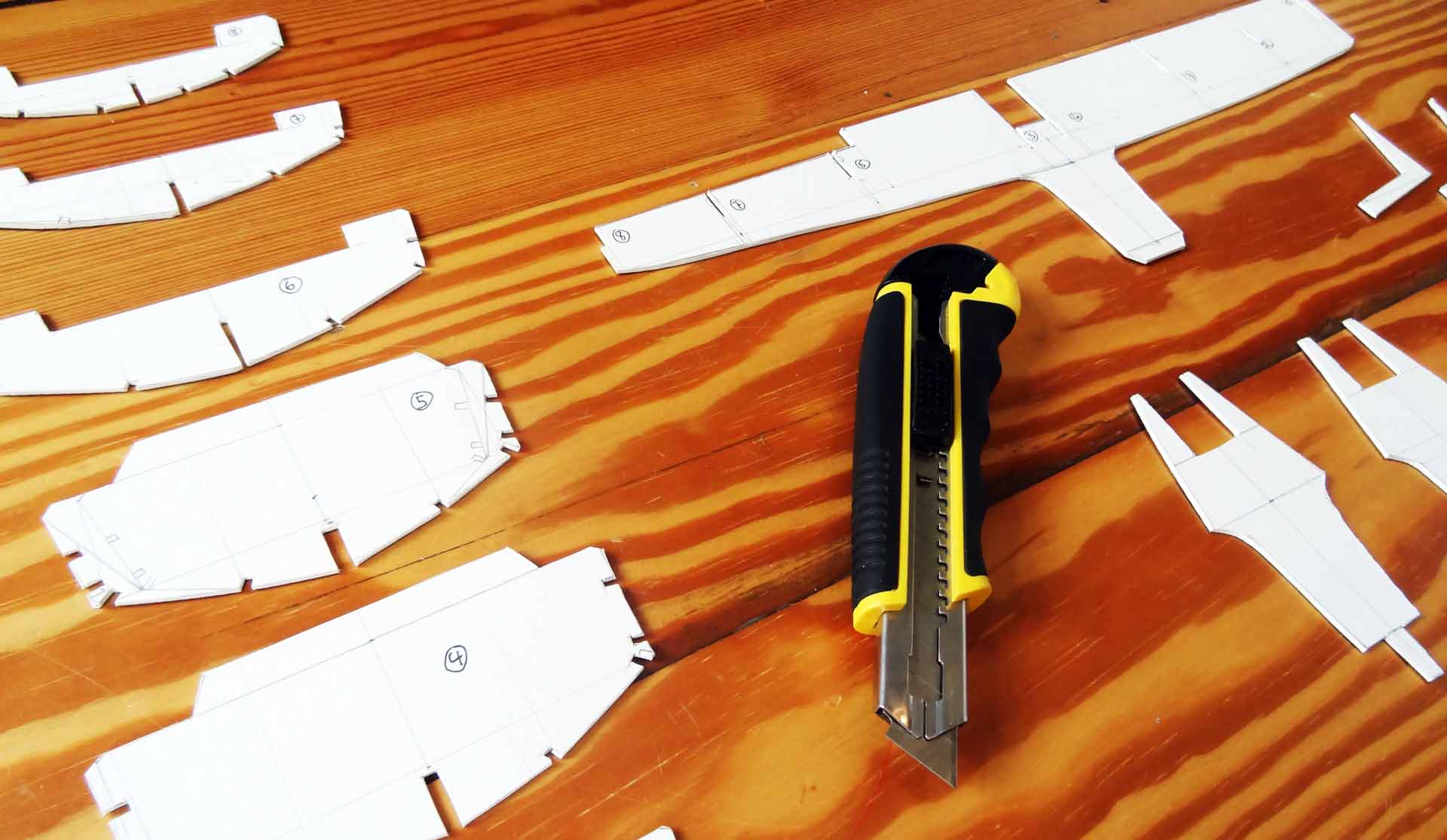
And after reading the all-standard book “The Principles of Yacht Design” (here´s my book review ) and talking to Alex Lang who is currently building his own Classe Mini 650 yacht from plywood (read the fascinating interview here ) I´ve decided to build my own Class 40 sailing vessel . Well. A small one … from cardboard.

I was lucky to find exact plans of a 40 feet sailing vessel – reminiscent of a Class 40 yacht – as part of the “Principles of Yacht Design”-Book. The ship is called YD-41 and the whole book is referring to this ship and explaining features of yacht design practically by showing things at the YD-41. So I did have a load of detailed plans and began to work my way through: Starting by transferring measurements of keel and bulkheads onto … well … strong cardboard. My boat is a small Class 40.
Length over all: 32 centimeters. What´s that fuzz all about, you may ask? It´s a tradition of my home town of Hamburg/Germany.
The Navel Ship. A Hamburg Tradition.
Let´s go back in time. Year 2013. My wife gave birth to our son. A great moving moment for every young mother and father. There are so many traditions after the arrival of newborn human beings on our earth, but this one was really griping me: I´ve read somewhere sometime that a Hamburg father should build a small boat into which the naval of the child s placed , when finally being lost by the child. This “navel ship” is then put into the waters of mighty river Elbe.
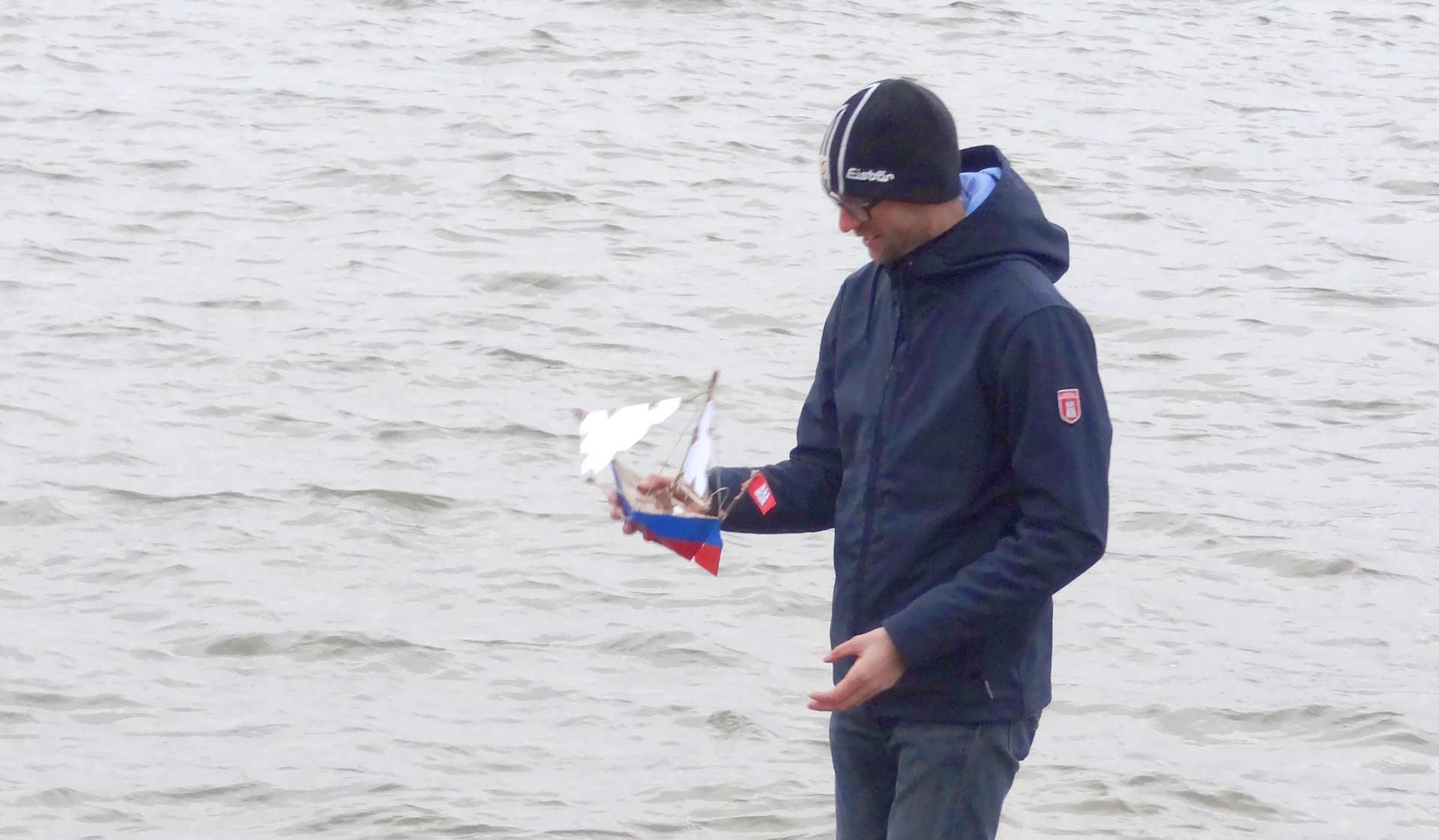
The navel ship will then proceed with the river, going down (ritually) into the North Sea. I particularly liked that tradition over others where one for example would have to bury the afterbirth and plant a tree upon it, because it had this certain naval aspect, a romantic sense and – over all – finally a ship involved. It suited us well because we as a family love the sea, love Hamburg and our river Elbe. So, some 3 years ago, I´ve built my first navel ship. From cardboard.
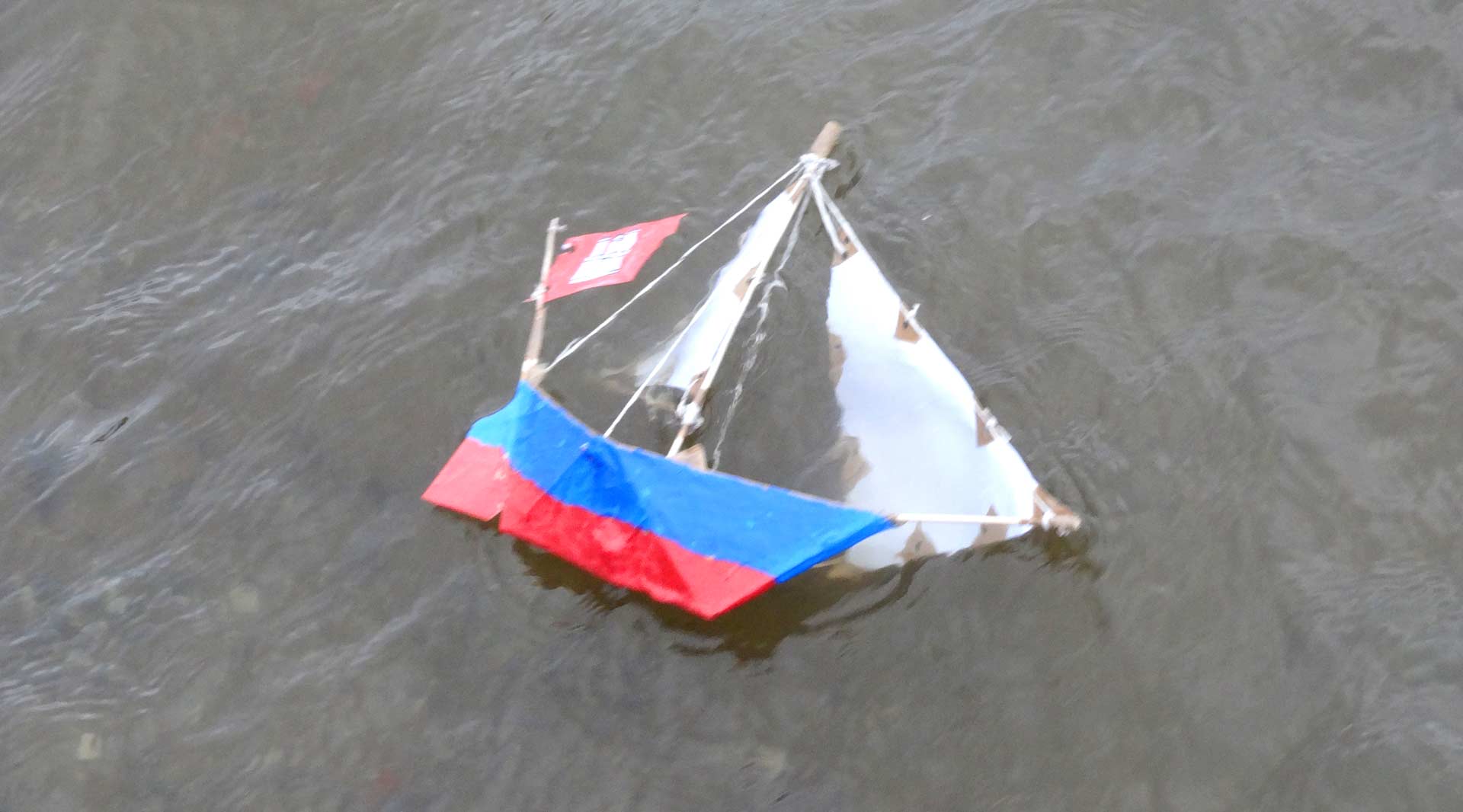
It was a clumsy boat to be honest. A bigger version of an ordinary child´s ship. But it still had a rig, a mainsail and a jib and was painted in Hamburg colors red and white. I was proud to having built it and the small family went to the shores of river Elbe where she was set afloat, accompanied by best wishes and Goodbye-waving for her journey. Also best wishes for luck, prosperity and overall health for our small son who was sleeping in his buggy.
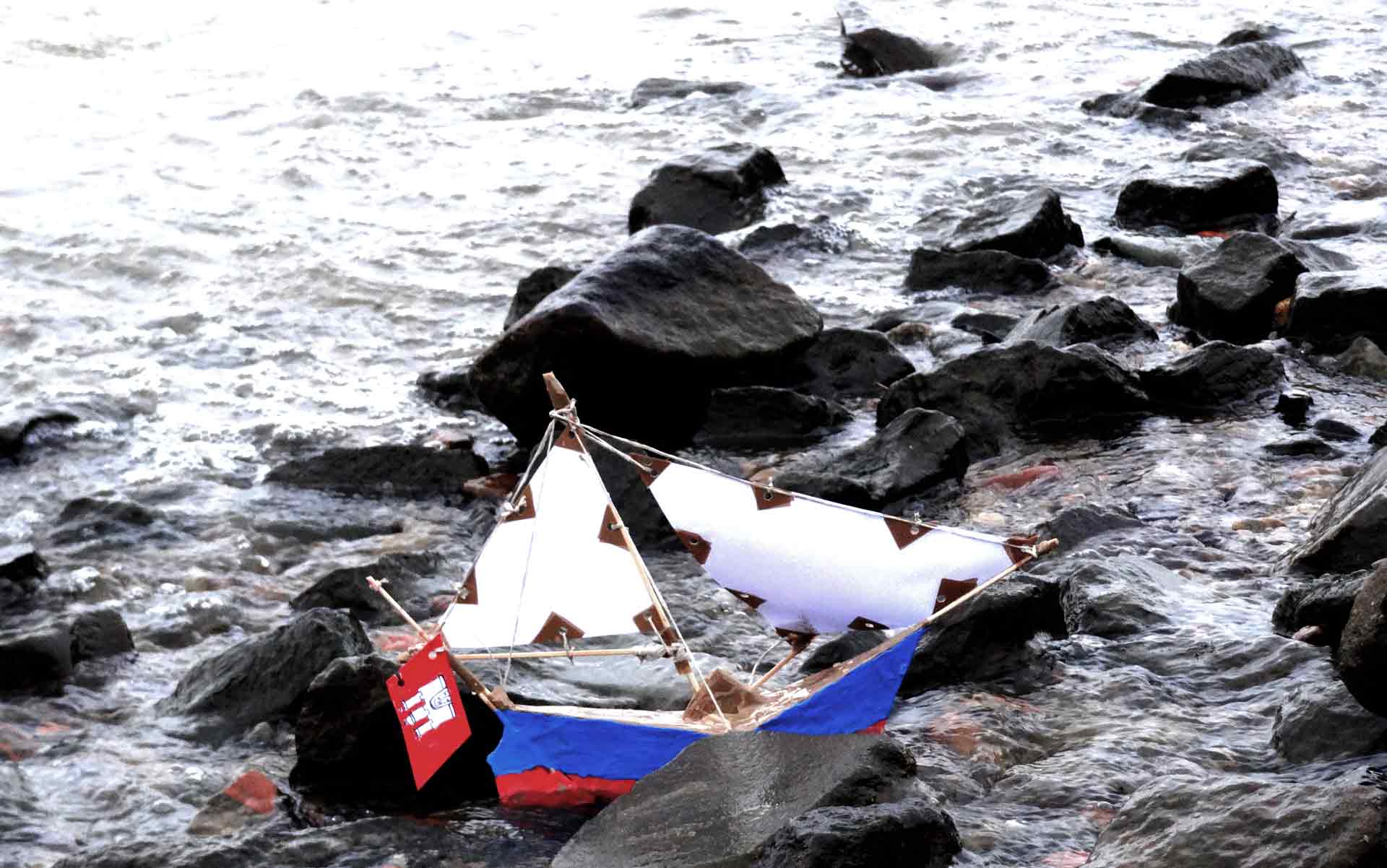
Oh my. The ship was poorly balanced as it lacked a proper keel , her rudder didn´t had any impact and so the NAVELSHIP 1 as she has been christened did capsize immediately after put into the waters, flushed by the cold floods of river Elbe and dramatically slow drifting ashore where she ran aground and finally sank . That´s was definitely not a magic moment of ship building indeed but nevertheless it was great fun to look at and after all tradition has been served.
As my wife got pregnant with our second son I saw my chance to make things better and to improve my construction. NAVELSHIP 2 would be a class of its own!
Bringing YD-41 to life.
So, three years later my second son is born and well and I take my chance of building not less than the best ever navel ship the river Elbe has seen to date. It should be full of grace, fast as hell, resemble the proud colors of the City of Hamburg of course and … well, a man´s work of a man´s own hands. The book “Principles of Yacht Design” was delivering the plans and after one or two hours of measuring, calculating and transferring the data onto cardboard, cutting out bulkheads and keel I glued together the first thirteen parts: Holding in my hands the principle structural construction of the Class 40 design. Even my wife was delighted, normally more or less shaking her head over my naval spleen (you know what I mean, don´t you?).
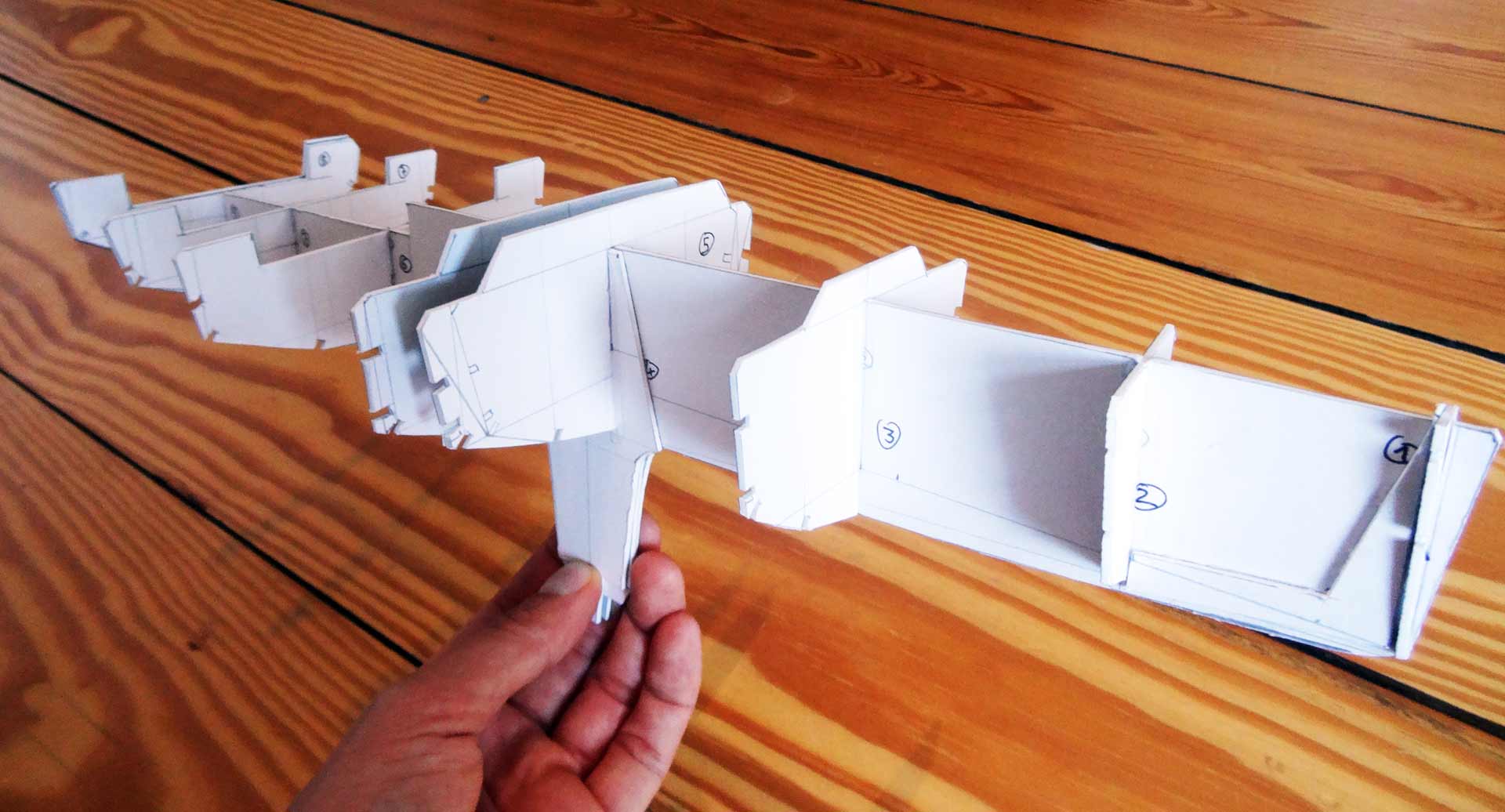
I was determined to have the Class 40 built according to the plans with a proper keel this time and of course a real rig resembling the principal functions: Halyards, sheets and sails made of Dacron-like material. In transferring measurements onto cardboard I noticed how hard it really is to work the material in an exact way: Even as I tried to be as accurate as possible I was puzzled by the huge allowances in the end. Boatbuilding is as hard as heart surgery it seems.
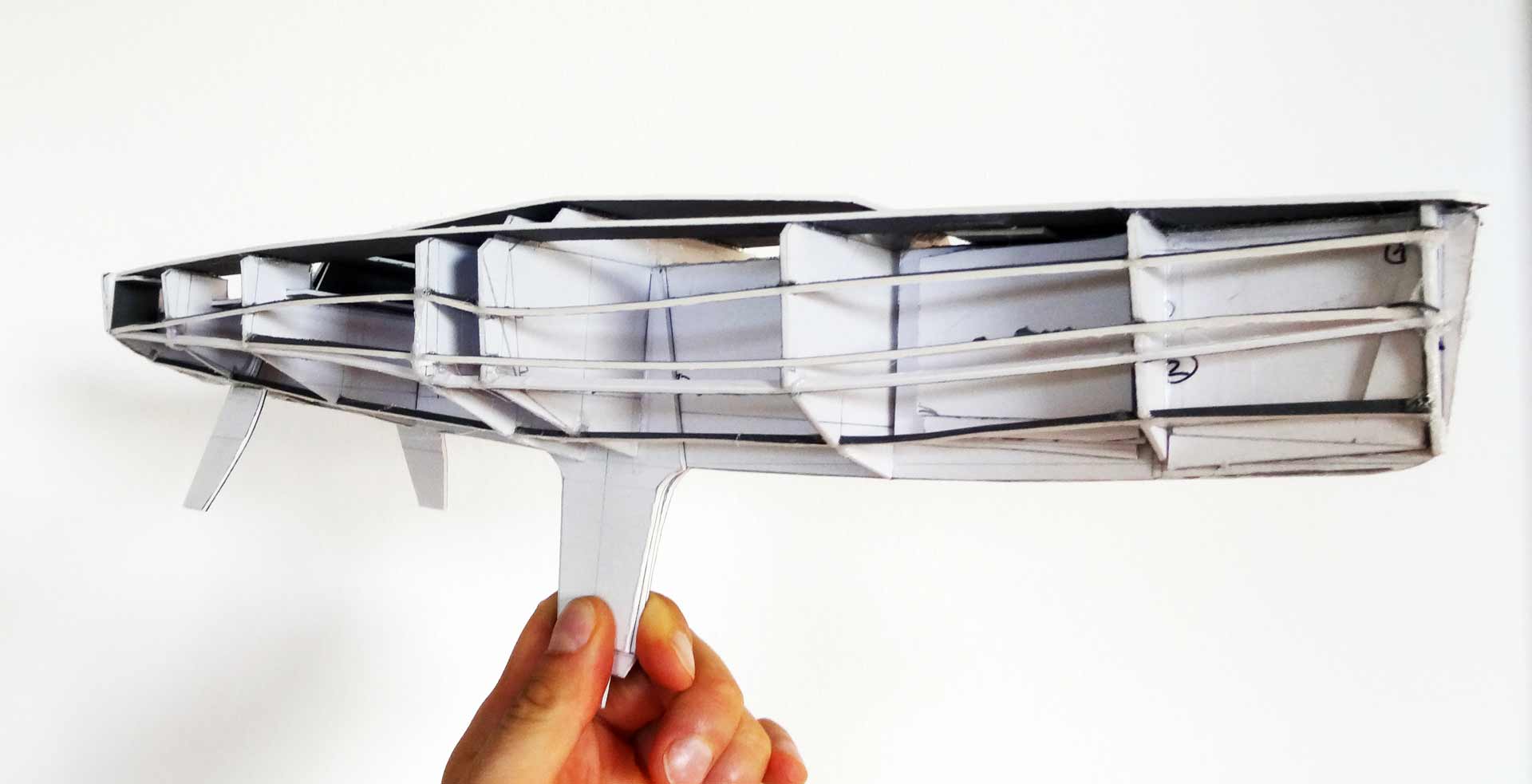
Even whilst working on a model ship I was determined to have her guilt like she was really going to be sailed through rough waters of the open ocean, so I added stringers to the skeleton which were then finally showing how inaccurate I have been working in the first place – instead of running down from bow to stern in a smooth straight line my stringers resembled an … well, kind of ugly finish. Nevertheless, as the glue hardened, the hull made a pretty stable impression.

I also added twin rudders, as I knew when pressed hard in the wind a Class 40 would heel significantly bringing the lee rudder out of the water and making the remaining rudder working efficient. But how to get the hull completed? A walk to the nearest home improvement store later, I´ve bought a can of insulating foam with which I foamed the whole hull. I did had an idea how to achieve a smooth surface of the hull.
The Class 40 receives a smooth Hull
Oh, what a day, when a week later the foam finally dried completely and I took out the sharp carpet knife and began to cut away the surplus foam material. Slowly the distinct shape of a Class 40 sailing yacht was pealing out of the bulky clunk of foam. It was as easy as ABC as I only had to cut along the stringers.

Slowly the neat lines of the YD-41 sailing yacht reappeared and the more I cut away the foam the more excited I got: Along with my son who is now some two and a half years old, watching daddy with big eyes and asking questions all the time. Showing the pictures of NAVELSHIP 1 to him, he began to jangle our nerves asking when the boat will hit the waters. And as we all know: Building a ship takes at least two times longer and will cost at least four times the estimated budgets .

Nevertheless, despite the price paid until now – some 130 Euros – the outcome was awesome and holding the hull, now made unsinkable, made me some kind of a proud boat builder. Hence I must admit, seeing her uneven lines, asymmetric hull and huge allowances would make a pro get white hair, but in this case it´s okay I would say.

Last item on the to-do list was working with filler. I began to apply one or two millimeters of filler to the foamy hull, waited a day and sanded it down to get a (relatively) smooth surface. Then I repeated the whole process another two times, achieving a thick enough hard hull, impermeable for water. Doesn´t she look pretty?
Final Preparations of the Class 40 Hull
Adding a keel was also kind of tricky. I first made another chunk of insulating foam, cutting it altogether to the shape of a lead-keel bulb. Then I again applied some – really thick – layers of filler and sanded it down. In the end I´ve got a both heavy bulb and a – relatively – bulb-shaped keel form. Bringing fin and bulb together was a matter of some drops of all-purpose-adhesive and that was finally it.
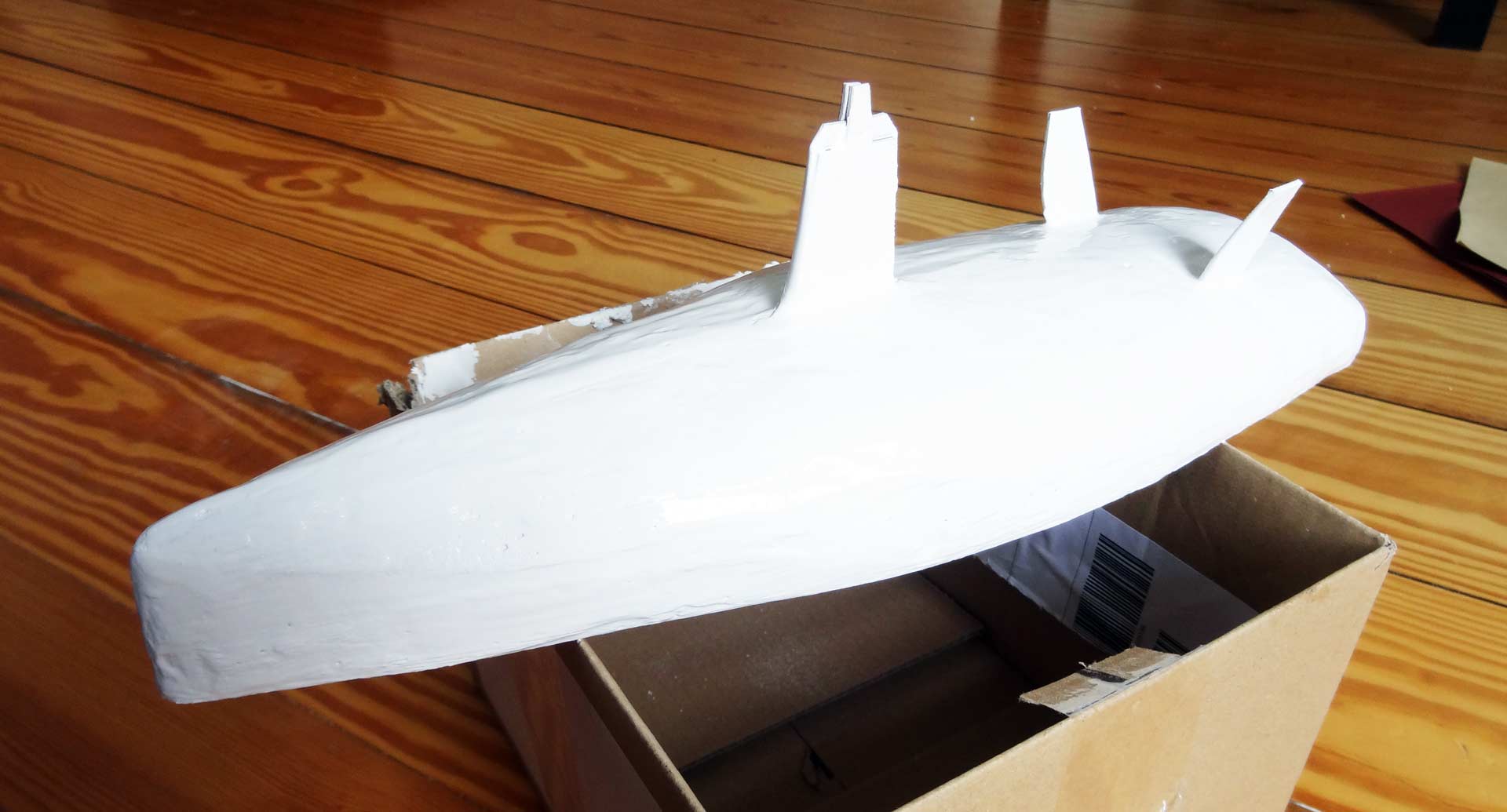
Next thing was the rig of which the main mast was the first thing to do. A simple wooden spar, cut to the exact size of the boat´s planned mast height taken from the plans I applied some boreholes for the boom and the halyards which will be installed later. Cutting the mast shoe I drilled the hole through the cabin roof, cut out some wood and glued the stepped mast onto the keel construction. A day of drying – perfect! Two spreaders round the picture.

So, as everything had dried thoroughly it was time to add a neat design to the boat. What´s a Class 40 without a cool design? It was clear from the beginning that I´d had to opt for the classic Hamburg colors: Red, Blue and White and so I finally did. Having two layers of Yacht-White applied to the boat I added dynamic blue graphics, resembling the swoosh of the seas. Painting the submerged surface in red added the final touch.
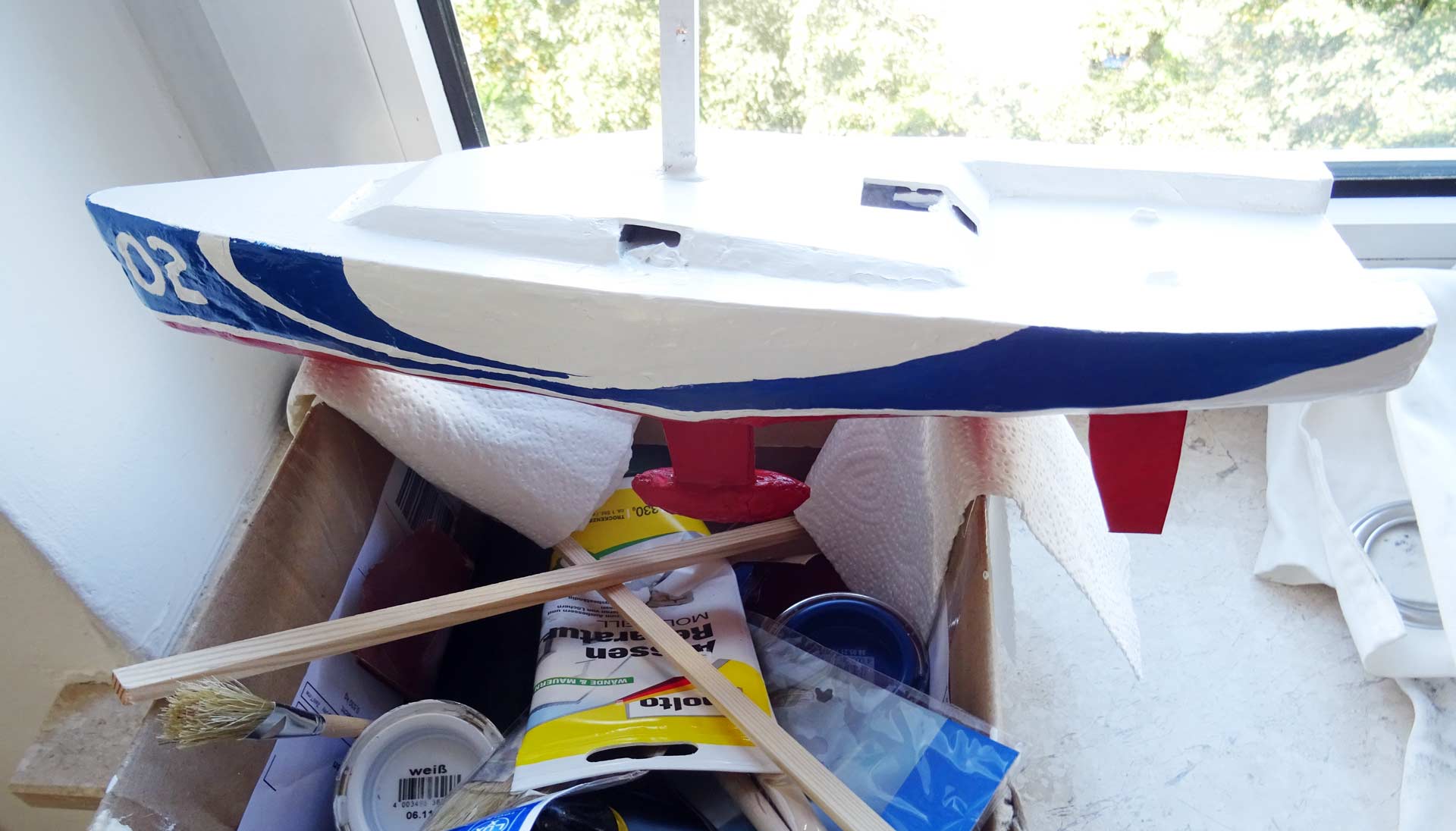
And here she comes: NAVELSHIP 2 (or in German NABELSCHIFF 2) was brought to water in the bathtub of my sons and – what a glorious day! – she swam! And she did not just only swim, she did exactly it to her waterline like as if it was intended. She is pretty stable I must say and behaving great as far as I could test in the tub.
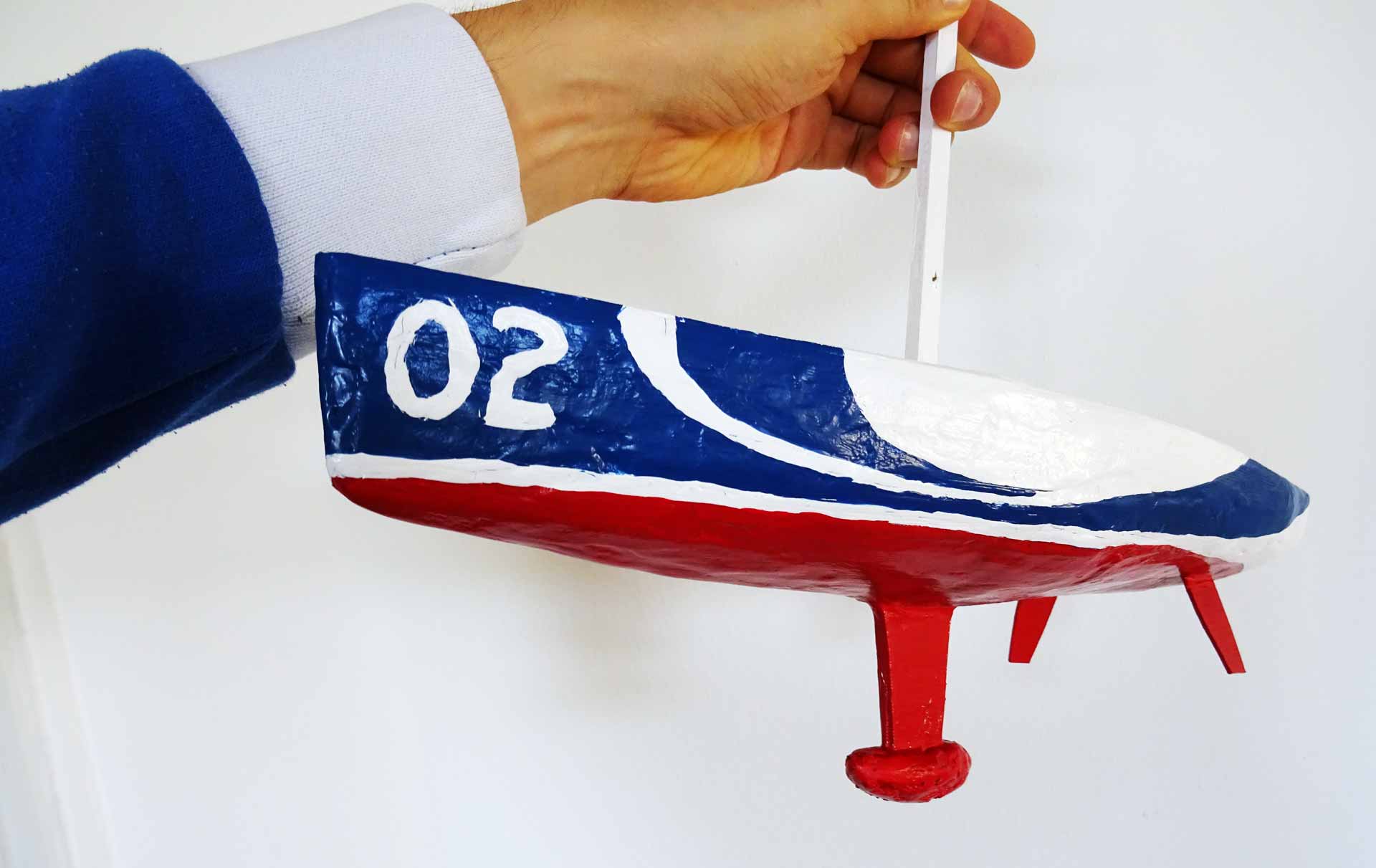
Now the boat is nearly finished. I am right now finishing her standing and running rigging, doing so experiments with cut out IKEA-bags for making her great blue sails and I guess within the coming weeks she will finally put to sea. The same way we did three years ago: Taking my family out on a fine day to strolling down to the shores of Elbe river, bringing the boat to her salty waters, waving goodbye and hoping that she will sail some (couple of) meters until, I fear, inevitably she will also capsize, run aground or simply sink.
But hey, that´s the fate of navel ships as the tradition demands it.
Here´s an interview with Marc Lombard, Merfyn Owen and Britton Ward on real Class 40 racing yachts
And an exciting read on Lizzy Foreman´s first moves aboard an IMOCA 60 racing yacht

- Presentation
- Board of Directors
- Races open to Class40
- Championship
- Class40 selection
- Minutes of the Executive Meeting
- Class rules
- Appendix to class rules
- FFV/world sailing documents
- Constitution and internal regulation

3 fiche(s). Page 1/1
- 20 août Palermo - Montecarlo
- 24 août Ida Lewis Distance race
- 15 sept. CIC Normandy Channel Race

1 fiche(s). Page 1/1
Class40 was born as a result of the distillation of excellent yet simple ideas. Designers, sailors and boat builders had been working on the idea of a dedicated offshore race boat for some years prior to the creation of the Class in 2004. A boat somewhere in between a Series Mini and an ocean-going 60 footer. A true race boat of course, but more than that… a boat sufficiently seaworthy to safely sail across the Atlantic. The Class40 was already well on its way… For several years, ideas had been based around a 40 footer, but had not yet taken form. In 2004, at the request of many people in the marine industry, skipper-journalist Patrice Carpentier took the initiative to draft the Rules for Class40. He brought together the skipper Michel Mirabel, Christian Bouroullec of the Structures Boatyard, and Pascal Jamet, CEO of Volvo and passionate about sailing. Between them, they created the "Class40" Association. Creative influences and moderating influences in the same boat... At the time, on the one hand there were boatyards with existing 40 footers. Of particular note was Structures' Pogo 8.50 which had just won the Transquadra, and the Jumbo 40 from the yard of the same name. These boat builders knew that there was a demand, and a market for this kind of boat. They wanted to find a framework and rules for this 40 footer aimed at enlightened and "wise" sailors. On the other hand, there was a group of designers and racers from the Classe Mini, full of talent and ideas, and fans of sailing at speed and surfing. "Patrice Carpentier managed to get these two groups, both of which were brimming with what appeared to be incompatible ideas, but which were in fact totally complementary, to work together" , explained Pascal Jamet. "There were creative influences and moderating influences... " Drawings of existing 40 footers, and boats which had yet to be built were put on the table. The brief contained three points: design a simple, reliable and fast boat. "We set ourselves the goal of making the rules fit onto two pages!" recalled Patrice Carpentier. "It took us about a year to define the rules, but it was fascinating! It isn't easy to get numerous designers around the table at the same time! They are all stubborn but utterly brilliant individuals!" recounted Pascal Jamet. 2005 Paris Boat Show: Class40 unveiled At the Paris Boat Show in 2005, the Class40 Rules and the broad outlines of this new offshore class were officially unveiled, and a race programme in which the 2006 Route du Rhum was to be the highlight. The conference room was packed. The audience was captivated: Class40 had its first success. The success of the Class was rapidly confirmed in the following months. The Pogo 40, the Jumbo 40 and then the Akilaria came out of their respective yards. Many designers took to the drawing board. The first prototypes appeared... "It happened very quickly! We were astounded by the enthusiasm generated by this Class!" recalled Pascal Jamet. And in fact, ten months later (a mere 10 months...), in October 2006, the Class already had 54 members, and 25 Class40s lined up for the start of the Route du Rhum! These 40 footers made up a third of the fleet in this mythical transatlantic race... Since then, Class40s systematically make up the largest fleet in the offshore races they take part in. In 2007, the Class40 Association had 129 members, and 30 of them were on the start line of the Transat Jacques Vabre. Since then, the Class has settled at 120 to 130 members per year, and a fleet of 40 or so boats which compete regularly. Conviviality is the catalyst In terms of quantity, the Class had made it. In terms of "quality", the brief was answered to perfection. "We wanted to create a Class for enlightened amateurs, and a race circuit accessible to all. A Class which enables all good sailors to fulfil their dream of offshore racing - easily, for pleasure, and without bankrupting themselves, or spending months in the yard on a complicated prototype," explained Michel Mirabel. It was spot on. Heads of companies and professionals who have kept a toe dipped in the water and the wind in their hair, make up the bulk of Class40 membership. Young semi-professional sailors have joined the fray. The end result is a successful mix of sailors. Everyone is delighted with their new-found freedom to do be able to do what they want: take part in offshore races. Friendships have formed from the earliest Class40 races. Memories are etched for good. This is the glue of Class40. Diversity: a long-term attribute Since its creation, Class40 has found its place in the world of offshore racing. It quickly expanded internationally: South Africa, Germany, England, Belgium, Bulgaria, Spain, USA, Holland, Italy, Norway... Today, Class40 is made up of sailors from 22 different countries. Patrice Carpentier sees this is a strength: "The mix of different types of people and the internationalisation of the Class are very good attributes. What makes Class40 so attractive is its diversity, and that makes me optimistic for the future." This diversity can also be seen in the lines of the Class40 boats themselves. Designers have had a ball finding ways to optimise the Class Rules. Inevitably, boats have steadily become more powerful. "Class40 is just fine as it is! We got the basics right, because not only have we been able to design very different boats within the same framework... but there are still lots of avenues for designers to explore," enthused François Lucas, designer, and one of the founding members of the Class. However, Michel Mirabel believes that it is crucial to remain faithful to the founding principles of Class40: "Where the rules are concerned, we need to systematically go for the solution which costs the least. It is the only way to prevent an arms race. We must stick firmly to this principle." A Class to watch... With undeniably good beginnings and now well-installed in the world of offshore racing, Class40 has won its first bet. For the future, the Class must find the right balance between performance and accessibility; between "pro" budget, and simply budget; between true offshore races and "grand prix" events open to all... Class40 is on course. It must make the right tactical decisions: those which enable sailors to fulfil their dreams. Author : Catherine Ecarlat

Money blog: 'Should I top up my national insurance and could it really get me £6,000 extra?'
Welcome to the Money blog, your place for personal finance and consumer news and tips. Today's posts include a Money Problem on the benefits or otherwise of topping up your national insurance. Leave your problem or consumer dispute below - remember to include contact details.
Monday 19 August 2024 07:49, UK
- Energy bills to rise 9% this winter - forecast
- Kellogg's shrinks size of Corn Flakes
Essential reads
- Money Problem : 'Should I top up my national insurance and could it really get me £6,000 extra?'
- Couples on how they split finances when one earns more than other
- Best of the Money blog - an archive of features
Tips and advice
- All discounts you get as student or young person
- Save up to half price on top attractions with this trick
- Fines for parents taking kids out of school increasing next month
Ask a question or make a comment
By Jimmy Rice, Money blog editor
Every Monday the Money team answers your Money Problems or consumer disputes. Find out how to submit yours at the bottom of this post. Today's question is...
I'm 62 and have 10 years of gaps in my national insurance record as I worked for my parents' import business without a fixed wage during most of my twenties and thirties, and had periods of unemployment in my fifties. What are the benefits of topping up before I retire in a few years and can I really get £6,000 added to my pension for every £900 I put in? Tony, Palmers Green
This is a question many people approaching retirement will be asking themselves, Tony.
First, it's worth us outlining why your national insurance record matters and who can top up.
If you reached pension age after 6 April 2016 you need 10 years of NI contributions to get a state pension - and 35 years to get the full £221.20 a week. Before that 2016 date, it's 30 years.
People may have gaps in their record for numerous reasons including: being unemployed, on a low income, self-employed, having worked abroad, or having taken a break from work to raise a family.
Ordinarily, you can pay voluntary contributions for the past six years - but currently there's an extended period meaning a man born after 5 April 1951 or a woman born after 5 April 1953 can pay voluntary contributions to make up for gaps between April 2006 and April 2016.
The deadline for this is 5 April 2025.
How much could topping up earn you?
It would cost £907.40 to cover all NI contributions from the 2023-24 tax year - each year is different but this is a good guide. Going back to your question, if you went on to enjoy 20 years of retirement, you would get back £6,000. It would take just three years to get your £907.40 back.
Who might want to think twice?
Just to stress, as always, that this post is not intended as financial advice. Instead, we're outlining things you should think about.
The first thing anyone should consider is if they'll fill gaps naturally through working - in which case there'd be no point topping up. Given your age, Tony, it could be an option for you - but check your state pension forecast here .
There are lots of other things to factor in and you should seek independent financial advice.
Wealth management firm Charles Stanley says a key consideration is whether a higher pension would either:
- Drag you into paying tax when you retire;
- Mean you no longer qualify for certain benefits.
"You might not benefit from the full amount of extra money as some will be taken in income tax," they say.
"In addition, boosting state pension income can affect entitlements to means-tested benefits. Notably, if you claim pension credit, which tops up the income of very low earners over state pension age, any increase in the state pension would normally reduce an award. This often means that you would be no better off paying voluntary contributions."
Another consideration - and this isn't something most people want to contemplate - is that if you don't think you'll live long enough into retirement (you might be in ill-health or have a terminal illness) to benefit from topping up, then it's probably not worth it.
People should also look into whether they could transfer contributions from their spouse or civil partner .
One more way to top up
Which? advises: "Ensure that you are getting any NI credits you are entitled to before contemplating paying voluntary NI contributions for a particular year.
"These are free and will apply, say, if you are caring for a child in the family as a parent or grandparent, claiming statutory sick pay or looking after a sick/disabled person."
If you're below state pension age, you can contact the Future Pension Centre to see if you'll benefit from topping up - they're on 0800 731 0175. If you already claim the state pension, call the Pension Service on 0800 731 0469.
Again, before taking any action you should seek independent financial advice.
If you do decide to top up, you'll need a Government Gateway account.
On there, you can see gaps, the cost of filling them and how much you could benefit - you can then pay online.
This feature is not intended as financial advice - the aim is to give an overview of the things you should think about. Submit your dilemma or consumer dispute via:
- The form above - you need to leave a phone number or email address so we can contact you for further details;
- Email [email protected] with the subject line "Money blog";
- WhatsApp us here.
Winter energy bills are projected to rise by 9%, according to a closely watched forecast.
The price cap from October to December will go up to £1,714 a year for the average user, Cornwall Insight says.
It would be a £146 rise from the current cap, which is controlled by energy regulator Ofgem and aims to prevent households on variable tariffs being ripped off.
The cap doesn't represent a maximum bill. Instead it creates an average bill by limiting how much you pay per unit of gas and electricity, as well as setting a maximum daily standing charge (which all households must pay to stay connected to the grid).
Ofgem will announce the October cap this Friday.
"This is not the news households want to hear when moving into the colder months," said the principal consultant at Cornwall, Dr Craig Lowrey.
"Following two consecutive falls in the cap, I'm sure many hoped we were on a steady path back to pre-crisis prices.
"However, the lingering impact of the energy crisis has left us with a market that's still highly volatile and quick to react to any bad news on the supply front.
"Despite this, while we don't expect a return to the extreme prices of recent years, it's unlikely that bills will return to what was once considered normal. Without significant intervention, this may well be the new normal."
Cornwall Insight warned that the highly volatile energy market and unexpected global events, such as the recent escalating tensions in the Russia-Ukraine war, could see prices rise further at the start of the new year.
To avoid this vulnerability, Cornwall Insight said domestic renewable energy production should increase and Britain should wean itself off energy imports.
Kellogg's appears to have shrunk its packets of Corn Flakes.
Two of its four different pack sizes have reduced in weight by 50g, according to The Sun.
What used to be 720g boxes are now 670g, while 500g boxes have become 450g.
The newspaper says the 670g boxes are being sold for £3.20 in Tesco - the same price customers were paying for the larger box back in May.
The 450g boxes are being sold for £2.19, only slightly less than the previous price of £2.25.
Other supermarkets have similar pricing, although in Morrisons the price has gone down in proportion to the size reduction.
The 250g and 1kg pack sizes remain unchanged.
Kellogg's has said it is up to shops to choose what they charge, but Tesco said the manufacturer should comment on pricing.
Sky News has contacted Kellogg's for comment.
A spokesperson is quoted by The Sun: "Kellogg's Corn Flakes are available in four different box sizes to suit different shopper preferences and needs.
"As the cost of ingredients and production processes increase, it costs us more to make our products than it used to.
"This can impact the recommended retail price. It's the grocer's absolute discretion and decision what price to charge shoppers."
WHSmith has launched a café brand as it seeks to expand into the food-to-go market.
The first café is in Princess Anne Hospital in Southampton and offers teas and coffees, hot breakfasts and pastries
Its branding is the same as the Smith Family Kitchen food-to-go range launched three months ago.
WHSmith UK travel managing director Andrew Harrison said: "Whether it's in a hospital or on their journeys, customers tell us that quality food and drink options are what they prioritise most in the different locations we serve.
"That's why we have been doubling down on our food ranges and formats to ensure our customers don't need to compromise on quality or value, as demonstrated today with the launch of Smith's Kitchen."
Thanks for popping into Money, our live blog for consumer and personal finance news and tips, as we kick off a new week. Here are five reasons to pop back over the coming days...
Topping up your national insurance
Coming up this morning is this week's Money Problem , focusing on a question from reader Tony, in Palmers Green, who wants to know if he could really add £6,000 to his retirement pot with a £900 top-up to his national insurance.
Bring back Spangles
Thousands of you have got involved in our Bring It Back series in the last few weeks, suggesting the old-school sweets or treats that you'd love to see revived. This week, published first thing tomorrow, we're looking at a classic that's been mentioned time and again in our comments section - Spangles. We'll be hearing what Mars had to say about a potential return.
Why should you pay with credit card?
We'll also take a deeper dive into one of the most common pieces of consumer advice: that you should try to pay on credit card for big purchases. Why do you get extra protection, how does it work and what is and isn't covered - we'll have all the answers in Tuesday's Basically .
Yorkshire pudding secrets from top Yorkshire chef in Cheap Eats
Anyone who makes their own Yorkshire puddings - or wants to - should check back on Wednesday morning as one of Yorkshire's top chefs, James Mackenzie from the Michelin-starred Pipe and Glass in South Dalton, picks his Cheap Eats in East Yorkshire and at home - revealing his secrets for perfect/huge Yorkies, including a common mistake many people make.
Everything to know about savings and mortgages
Every Thursday we hear from Savings Champion founder Anna Bowes, who offers some advice for making the most of your spare cash and reveals the best rates on the market right now. Then on Fridays we do similarly with mortgages, hearing from industry experts on what anyone seeking to borrow needs to know at the minute before rounding up the best rates with the help of the guys from Moneyfacts.
We've got lots of others tips and features planned for this week, so bookmark news.sky.com/money and check back from 7am each weekday - or 8am on Saturday for our weekend feature.
The Money blog is produced by the Sky News live team, with contributions from Bhvishya Patel, Jess Sharp, Katie Williams, Brad Young, Ollie Cooper and Mark Wyatt, with sub-editing by Isobel Souster. It is edited by Jimmy Rice.
By Emily Mee , news reporter
Openly discussing how you split your finances with your partner feels pretty taboo - even among friends.
As a consequence, it can be difficult to know how to approach these conversations with our partner or what is largely considered fair - especially if there's a big imbalance salary-wise.
Research by Hargreaves Lansdown suggests in an average household with a couple, three-quarters of the income is earned by one person.
Even when there is a large disparity, some couples will want to pay the same amount on bills as they want to contribute equally.
But for others, one partner can feel resentful if they are spending all of their money on bills while the other has much more to spend and is living a different lifestyle as a result.
At what stage of the relationship can you talk about money?
"We've kind of formally agreed there is some point in a relationship you start talking about kids - there is no generally agreed time that we start talking about money," says Sarah Coles, head of personal finance at Hargreaves Lansdown.
Some couples may never get around to mentioning it, leading to "lopsided finances".
Ms Coles says if you want to keep on top of finances with your partner, you could set a specific date in the year that you go through it all.
"If it's in the diary and it's not emotional and it's not personal then you can properly go through it," she says.
"It's not a question of 'you need to pull more weight'. It's purely just this is what we've agreed, this is the maths and this is how we need to do that."
While many people start talking about finances around Christmas, Ms Coles suggests this can be a "trying time" for couples so February might be a "less emotional time to sit down".
How do you have the conversation if you feel the current arrangement is unfair?
Relationship counsellor at Relate , Peter Saddington, says that setting out the balance as "unfair" shouldn't be your starting point.
You need to be honest about your position, he says, but your conversation should be negotiating as a couple what works for both of you.
Before you have to jump into the conversation, think about:
- Letting your partner know in advance rather than springing it on them;
- Making sure you and your partner haven't drunk alcohol before having the conversation, as this can make it easy for it to spiral;
- Having all the facts to hand, so you know exactly how much you are spending;
- Using 'I' statements rather than 'you'. For example, you could say to your partner: "I'm really worried about my finances and I would like to sit down and talk about how we manage it. Can we plan a time when we can sit down and do it?"
Mr Saddington says if your partner is not willing to help, you should look at the reasons or question if there are other things in the relationship that need sorting out.
If you're having repeated arguments about money, he says you might have opposite communication styles causing you to "keep headbutting".
Another reason could be there is a "big resentment" lurking in the background - and it may be that you need a third party such as a counsellor, therapist or mediator to help resolve it.
Mr Saddington says there needs to be a "safe space" to have these conversations, and that a third party can help untangle resentments from what is happening now.
He also suggests considering both of your attitudes to money, which he says can be formed by your early life and your family.
"If you grew up in a family where there wasn't any money, or it wasn't talked about, or it was pushed that you save instead of spend, and the other person had the opposite, you can see where those conversations go horribly wrong.
"Understanding what influences each of you when it comes to money is important to do before you have significant conversations about it."
What are the different ways you can split your finances?
There's no one-size-fits-all approach, but there are several ways you can do it - with Money blog readers getting in touch to let us know their approach...
1. Separate personal accounts - both pay the same amount into a joint account regardless of income
Paul Fuller, 40, earns approximately £40,000 a year while his wife earns about £70,000.
They each have separate accounts, including savings accounts, but they pay the same amount (£900) each a month into a joint account to pay for their bills.
Paul says this pays for the things they both benefit from or have a responsibility for, but when it comes to other spending his wife should be able to spend as she likes.
"It's not for me to turn around to my wife and expect her to justify why she thinks it's appropriate to spend £150 in a hairdresser. She works her backside off and she has a very stressful job," he says.
However, their arrangement is still flexible. Their mortgage is going up by £350 a month soon, so his wife has agreed to pay £200 of that.
And if his wife wants a takeaway but he can't afford to pay for it, she'll say it's on her.
"Where a lot of people go wrong is being unable to have those conversations," says Paul.
2. Separate personal accounts - whoever earns the most puts more into a joint account
This is a more formal arrangement than the hybrid approach Paul and his wife use, and many Money blog readers seem to do this in one form or another judging by our inbox.
There's no right or wrong way to do the maths - you could both put in the same percentage of your individual salaries, or come up with a figure you think is fair, or ensure you're both left with the same amount of spending money after each payday.
3. Everything is shared
Gordon Hurd and his wife Brenda live by their spreadsheet.
Brenda earns about £800 more a month as she is working full-time while Gordon is freelance. Previously Gordon had been the breadwinner - so it's a big turnaround.
They each have separate accounts with different banks, but they can both access the two accounts.
How much is left in each account - and their incomings and outgoings - is all detailed in the spreadsheet, which is managed weekly.
Whenever they need to buy something, they can see how much is left in each account and pay from either one.
Gordon says this means "everyone knows how much is available" and "each person's money belongs to the other".
"We have never in the last decade had a single disagreement about money and that is because of this strategy," he says.
Money blog reader Shredder79 got in touch to say he takes a similar approach.
"I earn £50k and my wife earns just under £150k. We have one joint bank account that our wages go into and all our outgoings come out of. Some friends can't get their head around that but it's normal for us."
Another reader, Curtis, also puts his wages into a joint account with his wife.
"After all, when you have a family (three kids) it shouldn't matter who earns more or less!" he says.
Reader Alec goes further and says he questions "the authenticity of any long-term relationship or the certainly of a marriage if a couple does not completely share a bank account for all earnings and all outgoings".
"As for earning significantly more than the other, so what? If you are one couple or long-term partnership you are one team and you simply communicate and share everything," he says.
"Personally I couldn't imagine doing it any other way and I do instinctively wonder what issues or insecurities, whether it be in trust or something else, sit beneath the need to feel like you need to keep your finances separate from one another, especially if you are a married couple."
A reader going by the name lljdc agrees, saying: "I earn half of what my husband does because I work part-time. Neither of us has a solo account. We have one joint account and everything goes into this and we just spend it however we like. All bills come out of this too. Sometimes I spend more, sometimes he spends more."
4. Separate accounts - but the higher earner pays their partner an 'allowance'
If one partner is earning much more than the other, or one partner isn't earning for whatever reason, they could keep separate accounts and have the higher earner pay their partner an allowance.
This would see them transfer an agreed amount each week or month to their partner's account.
Let us know how you and your partner talk about and split finances in the comments box - we'll feature some of the best next week
The centre-point of a significant week in the economy was inflation data, released first thing on Wednesday, that showed price rises accelerated in July to 2.2%.
Economists attributed part of the rise to energy prices - which have fallen this year, but at a much slower rate than they did last year.
As our business correspondent Paul Kelso pointed out, it felt like the kind of mild fluctuation we can probably expect month to month now that sky high price hikes are behind us, though analysts do expect inflation to tick up further through the remainder of the year...
Underneath the bonnet, service inflation, taking in restaurants and hotels, dropped from 5.7% to 5.2%.
This is important because a large part of this is wages - and they've been a concern for the Bank of England as they plot a route for interest rates.
On Tuesday we learned average weekly earnings had also fallen - from 5.7% to 5.4% in the latest statistics.
High wages can be inflationary (1/ people have more to spend, 2/ employers might raise prices to cover staff costs), so any easing will only aid the case for a less restrictive monetary policy. Or, to put it in words most people use, the case for interest rate cuts.
Markets think there'll be two more cuts this year - nothing has changed there.
Away from the economy, official data also illustrated the pain being felt by renters across the UK.
The ONS said:
- Average UK private rents increased by 8.6% in the 12 months to July 2024, unchanged from in the 12 months to June 2024;
- Average rents increased to £1,319 (8.6%) in England, £748 (7.9%) in Wales, and £965 (8.2%) in Scotland;
- In Northern Ireland, average rents increased by 10% in the 12 months to May 2024;
- In England, rents inflation was highest in London (9.7%) and lowest in the North East (6.1%).
Yesterday, we found the UK economy grew 0.6% over three months to the end of June.
That growth rate was the second highest among the G7 group of industrialised nations - only the United States performed better with 0.7%, though Japan and Germany have yet to released their latest data.
Interestingly, there was no growth at all in June, the Office for National Statistics said, as businesses delayed purchases until after the general election.
"In a range of industries across the economy, businesses stated that customers were delaying placing orders until the outcome of the election was known," the ONS said.
Finally, a shout for this analysis from business presenter Ian King examining what's gone wrong at Asda. It's been one of our most read articles this week and is well worth five minutes of your Friday commute or weekend...
We're signing out of regular updates now until Monday - but do check out our weekend read from 8am on Saturday. This week we're examining how couples who earn different amounts split their finances.
Each week we feature comments from Money blog readers on the story or stories that elicited most correspondence.
Our weekend probe into the myriad reasons for pub closures in the UK prompted hundreds of comments.
Landlords and campaigners, researchers and residents revealed to Sky News the "thousand cuts" killing Britain's boozers - and what it takes to survive the assault.
Here was your take on the subject...
I've been a publican for 19 years. This article is bang on! It's like you've overheard my conversations with my customers - COVID, cost of living, wages - the traditional British boozer going out of fashion. (My place: no food, no small children). Hey Jood
I own a small craft ale bar or micropub as some say. The current climate is sickening for the whole hospitality sector. This summer has been ridiculously quiet compared to previous ones. Micropubs were on the rise pre-COVID, but not now even we're struggling to survive… Lauren
I am an ex-landlord. It's ridiculous you can buy 10 cans for £10 or one pint for £5 now. It's not rocket science, it's a no-brainer: reverse the situation. Make supermarket beer more expensive than pub beer, then people will start to go out and mix again rather than getting drunk at home. Ivanlordpeers
Bought four pints of my regular drink at a supermarket for less than one pint in our local pub. It's becoming a luxury to go to a pub these days. Torquay David
Traditional pubs are being taken over by conglomerates who don't sell traditional beer, only very expensive lager, usually foreign, and other similar gassy drinks. How can they be called traditional pubs? Bronzestraw
The main reason for pubs closing is twofold! 1: The out-of-reach rents that the big groups charge landlords. 2: Landlords are told what stock they can hold and restrict where they can purchase it from. Strange, but most pubs belonged to the same groups! A pub-goer
Less pubs are managed now, pub companies are changing them to managed partnerships, putting the pressure onto inexperienced young ex-managers. Locals complain that their local pub has gone. but they don't use them enough. Can government regulate rents and beer prices for business owners? John Darkins
I was a brewery tenant in Scotland for many years and sequestrated because of the constant grabbing at my money by greedy brewers who wanted more and more. I made my pub very successful and was penalised by the brewery. James MacQuarrie
The only reason pubs are closing is locals only use them on Boxing Day, New Year's Eve, and one Sunday a year. Plus breweries don't need pubs, they sell enough through supermarkets! Use them or lose them. Peter Smith
The closing of pubs is a terrible shame. I still go to my local and have great memories of getting drunk in many in my hometown. They are important places in society. As someone once said: "No good story ever started with a salad." Kev K
It's the taxman killing pubs. £1 of every £3 sold. Utter disgrace. Stef
I go with my girlfriend, Prue, every day to my local. It's a shame what's happening to prices. It used to be full of people and joy but now it's a ghost town in the pub since prices are too high now. I wish we could turn back time and find out what went wrong. Niall Benson
Minimum wage is around £11 and the tax threshold is £12,600 per year. How can you possibly afford a night in a pub out when a pint costs between £3 and £8 a pint on those wages? Allan7777blue
Unfortunately, the very people who have kept these establishments going over the years (the working man) have been priced out, and they're paying the price. Dandexter
The pubs are too expensive for people to go out regularly as we once did a decade or so ago. People's priorities are on survival, not recreation. Until the living wage increases beyond an inflation that wages haven't risen above in years, then we will see shops, pubs, etc. close JD
Who wants to spend hard-earned money going into a pub that's nearly always empty. It takes away one of the main attractions - socialising. Michael
Monzo has been named the best bank in the UK for customer satisfaction, according to a major survey.
More than 17,000 personal current account customers rated their bank on the quality of its services and how likely they would be to recommend to friends or family.
Digital banks made up the top three, with Monzo coming out on top, followed by Starling Bank and then Chase.
Some 80% of Monzo customers said they would recommend the bank.
The digital banking app said topping the tables "time and time again" was not something it would "ever take for granted".
Royal Bank of Scotland (RBS) was bottom of the ranking for another year.
The banks with the best services in branches were Nationwide, Lloyds Bank and Metro Bank.
Gail's bakery chain has come under fire for repurposing unsold pastries into croissants and selling them for almost £4 the next day.
The retailer lists the "twice baked" chocolate almond croissants as part of its "Waste Not" range, which means it is made using leftover croissants that are then "topped with almond frangipane and flaked almonds".
The scheme has been hit with criticism online, with many pointing out the £3.90 price tag is 95p more than the original croissant.
One X user said: "The audacity of bragging about it being part of their 'Waste Not' range like we should be grateful to them and proud of ourselves for contributing to reducing food waste when they could just sell it for less money – not one pound more than yesterday.
"Unsure whether to be impressed or horrified that someone has come up with a concept to capitalise on yellow sticker goods to make more profit."
It should be added, however, that the practice was not invented by Gail's - and almond croissants were originally created by French boulangeries to reuse day-old croissants and stop them going stale.
When factoring in the extra ingredients (almond frangipane and flaked almonds) and baking time, the bakery chain would likely defend the increased price by pointing to the additional costs incurred.
It comes as locals in a trendy London neighbourhood signed a petition against a Gail's bakery setting up shop in their area.
After (unconfirmed) rumours began circulating that the chain was looking to open a site in Walthamstow village, more than 600 have signed a petition opposing the plans.
The petition says the village "faces a threat to its uniqueness" should Gail's move into the area (see yesterday's 11.54am post for more).
Gail's has been contacted for comment.
Be the first to get Breaking News
Install the Sky News app for free


An official website of the United States government
Here’s how you know
Official websites use .gov A .gov website belongs to an official government organization in the United States.
Secure .gov websites use HTTPS A lock ( Lock A locked padlock ) or https:// means you’ve safely connected to the .gov website. Share sensitive information only on official, secure websites.
Negotiating for Lower Drug Prices Works, Saves Billions
Biden-Harris Administration delivers on promise to lower prescription drug costs for Americans
In a historic moment that will help lower prescription drug prices for millions of people across America, the Biden-Harris Administration announced that it has reached agreements for new, lower prices for all 10 drugs selected for negotiations. These negotiated drugs are some of the most expensive and most frequently dispensed drugs in the Medicare program and are used to treat conditions such as heart disease, diabetes, and cancer. The new prices will go into effect for people with Medicare Part D prescription drug coverage beginning January 1, 2026.
If the new prices had been in effect last year, Medicare would have saved an estimated $6 billion, or approximately 22 percent, across the 10 selected drugs. These negotiated prices range from 38 to 79 percent discounts off of list prices. About nine million people with Medicare use at least one of the 10 drugs selected for negotiation. People with Medicare prescription drug coverage are expected to see aggregated estimated savings of $1.5 billion in their personal out-of-pocket costs in 2026. For more detailed information about the negotiated prices please see the Centers for Medicare & Medicaid Services (CMS) Negotiated Prices Fact Sheet .
“Americans pay too much for their prescription drugs. That makes today’s announcement historic. For the first time ever, Medicare negotiated directly with drug companies and the American people are better off for it,” said U.S. Department of Health and Human Services (HHS) Secretary Xavier Becerra. “Congressional budget estimators (Congressional Budget Office) predicted about $100 billion savings over 10 years from drug negotiations, and a $3.7 billion savings in the first year alone. Today we’re announcing that in our first year of negotiations we are saving Medicare an estimated $6 billion and Americans who pay out of pocket will be saving another $1.5 billion moving forward. Empowering Medicare to negotiate prices not only strengthens the program for generations to come, but also puts a check on skyrocketing drug prices.”
“CMS is proud to have negotiated drug prices for people with Medicare for the first time. These negotiations will not only lower the prices of critically important medications for cancer, diabetes, heart failure, and more, but will also save billions of dollars,” said CMS Administrator Chiquita Brooks-LaSure. “Medicare drug price negotiation and the lower prices announced today demonstrate the commitment of CMS and the Biden-Harris Administration to lower health care and prescription drug costs for Americans. We made a promise to the American people, and today, we are thrilled to share that we have fulfilled that promise.”
As a hypothetical example, a senior with Medicare who takes Stelara pays a 25% coinsurance on the drug which may amount to about $3,400 today for a 30-day supply. When the negotiated price goes into effect in 2026, that same 25% coinsurance would cost the beneficiary about $1,100 before the person reaches the catastrophic cap, after which the beneficiary will pay no more out of pocket on their prescription drugs. A beneficiary’s actual costs will depend on their plan’s benefit design.
In August 2023, HHS announced the first 10 drugs covered under Medicare Part D selected for the first cycle of negotiations.
The selected drugs accounted for $56.2 billion in total Medicare spending, or about 20 percent of total Part D gross spending in 2023. Overall, total Part D gross spending for the 10 selected drugs more than doubled from 2018 to 2022, from about $20 billion to about $46 billion, an increase of 134 percent. Medicare enrollees paid a total of $3.4 billion in out-of-pocket costs in 2022 for these drugs.
“CMS negotiated in good faith on behalf of the millions of people who rely on these 10 drugs for their health and well-being. The new negotiated prices will bring much needed financial relief, affordability, and access,” said Meena Seshamani, MD, PhD, CMS Deputy Administrator and Director of the Center for Medicare. “Throughout the process, we remained true to our commitment to be thoughtful and transparent, meeting publicly with patients, providers, health plans, pharmacies, drug companies and others to help inform the process. We will continue to do so for future cycles. Our team is actively working on the next cycle of negotiations where we will combine what we have learned from this first cycle and apply it in negotiating prices for the next round of up to 15 selected drugs.”
The Office of the Assistant Secretary for Planning and Evaluation (ASPE) also released new data today detailing historic pricing trends of the 10 drugs selected for the first cycle of the negotiation program. The report finds that from 2018 to 2023, list prices increased as much as 55 percent.
CMS will select up to 15 more drugs covered under Part D for negotiation for 2027 by February 1, 2025. CMS will select up to 15 more drugs covered by Part B or Part D for 2028, and up to 20 more Part B or Part D drugs for each year after that, as required by the Inflation Reduction Act.
In addition to these newly negotiated prices, people with Medicare are already experiencing lower drug costs thanks to the Inflation Reduction Act. And, next year, all Medicare Part D enrollees will benefit from a $2,000 out-of-pocket cap on their prescription drug costs, further making prescription drugs more affordable for seniors and people with disabilities.
View the CMS Negotiated Prices Fact Sheet at https://www.cms.gov/files/document/fact-sheet-negotiated-prices-initial-price-applicability-year-2026.pdf
View the Historic Trends Fact Sheet from the Office of the Assistant Secretary for Planning and Evaluation (ASPE) at https://aspe.hhs.gov/reports/medicare-drug-price-negotiation-program-comparing-drug-price
View a CMS Plain Language infographic at https://www.cms.gov/files/document/infographic-negotiated-prices-maximum-fair-prices.pdf
For more information about the Inflation Reduction Act, including plain language materials, please visit LowerDrugCosts.gov . For more information available in Spanish, please visit MedicamentosBajoPrecio.gov .
Sign Up for Email Updates
Receive the latest updates from the Secretary, Blogs, and News Releases
Subscribe to RSS
Receive latest updates

Related News Releases
Commemorating the 2nd anniversary of the biden-harris lower cost prescription drug law, biden-harris administration releases final part two guidance to help people with medicare prescription drug coverage manage prescription drug costs, hhs announces cost savings for 64 prescription drugs thanks to the medicare rebate program established by the biden-harris administration’s lower cost prescription drug law, media inquiries.
For general media inquiries, please contact [email protected] .
Disclaimer Policy: Links with this icon ( ) mean that you are leaving the HHS website.
- The Department of Health and Human Services (HHS) cannot guarantee the accuracy of a non-federal website.
- Linking to a non-federal website does not mean that HHS or its employees endorse the sponsors, information, or products presented on the website. HHS links outside of itself to provide you with further information.
- You will be bound by the destination website's privacy policy and/or terms of service when you follow the link.
- HHS is not responsible for Section 508 compliance (accessibility) on private websites.
For more information on HHS's web notification policies, see Website Disclaimers .

IMAGES
COMMENTS
A monohull is a boat with a single flotation plane at rest or under sail, whose hull depth in any transversal section shall not decrease towards the centreline. The current World Sailing (RRS, ERS and OSR) rules apply. The Rules for Class 40 Monohulls are the open type set out in Paragraph C.2.3 of the ERS (Equipment Rules of
Class40 rules Page 7 / 22 Version March 2024 102.02 - Mast rotation Rotating masts are forbidden. 102.03 - Mast cant Canting a mast is forbidden. 103. SAILS 103.01- General provisions The total number of sails on board is limited to 8. Within this total of 8 sails, boats are required to carry the following: 1 mainsail, 1 solent, 1 heavy-weather jib, 1 storm jib, and 1 storm trysail if the ...
The Class40 association gathers the skippers of Class40 yachts and any person interested in their evolution. The Class40 is a monohull sailboat sea-oriented racing and cruising with a maximum length is 40 feet. The original goal of the class was to make offshore races accessible to amateur sailors.
The Class 40 is a cheaper boat that can be sailed competitively in a range of conditions either short handed, by two people, or a solo sailor. The class is active in Europe, but growing in North America. Boats are built on a semi-production or custom basis. The class rules though work to keep the boat affordable, limiting exotic materials and ...
The Class 40 is a fast and powerful offshore monohull that offers thrilling and challenging sailing for professional and amateur sailors. Discover more about the design, rules and events of this World Sailing recognized class on the official website.
Title: 2020 Class Rules - Class 40 (April 2020) Description: Global Partners Anti-Doping. Participation & Development. Athlete Profiles. Rankings. Categorisation. Find an Official. Get the Racing Rules App. Contact Us. Contact Us. World Sailing Office 401, 4th Floor 3 Shortlands London ...
The Class 40 began in 2004 as a scaled-down, less-expensive version of the Open 60 and Open 50 monohulls that are the darlings of professional shorthanded offshore racing in Europe. The idea was to give amateurs an affordable class that was a step up from the Mini Transat 6.5, but pros have since embraced the boat as well.In the 2006 Route du Rhum race from France to Guadeloupe, 25 Class
The Class 40 attracts keen shorthanded sailors and designers alike as a breeding ground for champions and innovation. ... higher-profile boats, the Class40 is the most successful 40-footer of all ...
Reviewing a Class 40 Interior. Down below a Class 40 like the Pogo 40 is a true miracle regarding space. She is a 40 ft. boat - I personally find 40 feet with more than 12.50 meters huge compared to my 33 ft. King´s Cruiser - but due to her extreme width of 4.50 meters internal space is just huge! Even with 5 adults leaving their berths ...
T COMPLIANCE CERTIFICATE (MCC)1.0 OBJECTIVES - The Farr 40 is a high performance One Design racing yacht created for amateur helmsmen racing at top level international regattas under these Class rules, the IMS rule and o. er existing handicap systems. The Class Rules are intended to ensure that Farr 40 yachts are as ident.
Britton Ward/Kiwi 40 FC: "From its inception the Class 40 rule has sought to promote fast, high performance offshore-capable boats that are well-suited to short-hand-sailing. This is the result of a relatively strict and stable set of rule controls that try to limit build costs and produce equitable performance between different boats.
A monohull is a boat with a single flotation plane at rest or under sail, whose hull depth in any transversal section shall not decrease towards the centreline. The current World Sailing (RRS, ERS and OSR) rules apply. The Rules for Class 40 Monohulls are the open type set out in Paragraph C.2.3 of the ERS (Equipment Rules of
Class 40 is a class of offshore monohull sailboat, raced mainly short-handed and which the main characteristics are defined by box and restriction rules. 4 sailboat specifications , between 40 ft (12.1 m) and 40 ft (12.2 m), are available in the Class 40 collection on Boat-Specs.com:
Association Class40 - Centre de formation aux métiers de la mer - Allée du frère Maximin - 85 100 Les Sables d'Olonne - France. ©2013-2024 - &.
Class 40 is a box rule that has produced boats that are capable of racing fully crewed (typically 3-5 persons) in classic events such as the Fastnet, Bermuda Race, as well as short-handed in races such as the AZAB, TJV and Atlantic Cup. With our latest design that has changed: Dragon 2 has been specifically designed for the Route du Rhum, with ...
Commercial yacht. A motor or sailing vessel in commercial use (i.e. charter) for sport and pleasure, carrying no cargo and not more than 12 passengers. Private yacht. A pleasure vessel solely used for the recreational and leisure purpose of its owner and his guests. Flag administration.
The Class 40 receives a smooth Hull. Oh, what a day, when a week later the foam finally dried completely and I took out the sharp carpet knife and began to cut away the surplus foam material. Slowly the distinct shape of a Class 40 sailing yacht was pealing out of the bulky clunk of foam. It was as easy as ABC as I only had to cut along the ...
Electric Yacht. SeaWaterPro. SBD App Non-BR. top 1 ads row1. top 2 ads row2. top 3 ads row2. Class 40 . www.class40.com. International Class 40 web site. Related Sailboats: Sort by:
Two Class 40's did the Fastnet 2-handed they are not an IRC boat and both corrected way down Pogo 40 (IRC TCC 1.27) and a Jumbo 40 (1.22) - there was an Open 40 too at 1.22 Ratings under IRC can vary widely depending upon which sails you rate in and whether you declare you will not use the water ballast - an Open or Class 40 with their biggest ...
Apr 6, 2020. #13. That Open 40 got a shortened aluminum mast and they guy is holding firm on his price. Knew someone who made him several offers late last year and he held firm. A proper replacement mast costs more than what he is asking for the boat. You can now get early gen. Class 40s <$100k.
Since then, the Class has settled at 120 to 130 members per year, and a fleet of 40 or so boats which compete regularly. Conviviality is the catalyst In terms of quantity, the Class had made it. In terms of "quality", the brief was answered to perfection. ... Designers have had a ball finding ways to optimise the Class Rules. Inevitably, boats ...
Class 40. Class 40 is a yacht builder that currently has 22 yachts for sale on YachtWorld, including 1 new vessels and 21 used yachts, listed by experienced yacht brokers and boat dealerships mainly in the following countries: France, Croatia, Sweden, United States and United Kingdom. Models currently listed on YachtWorld span in size and ...
It would cost £907.40 to cover all NI contributions from the 2023-24 tax year - each year is different but this is a good guide. Going back to your question, if you went on to enjoy 20 years of ...
1.0 OBJECTIVES - The Farr 40 is a high performance One Design racing yacht created for amateur helmsmen racing at top level international regattas under these Class rules, the IMS rule and other existing handicap systems. The Class Rules are intended to ensure that Farr 40 yachts are as identical as possible in respect of: • appearance
Biden-Harris Administration delivers on promise to lower prescription drug costs for Americans. In a historic moment that will help lower prescription drug prices for millions of people across America, the Biden-Harris Administration announced that it has reached agreements for new, lower prices for all 10 drugs selected for negotiations.